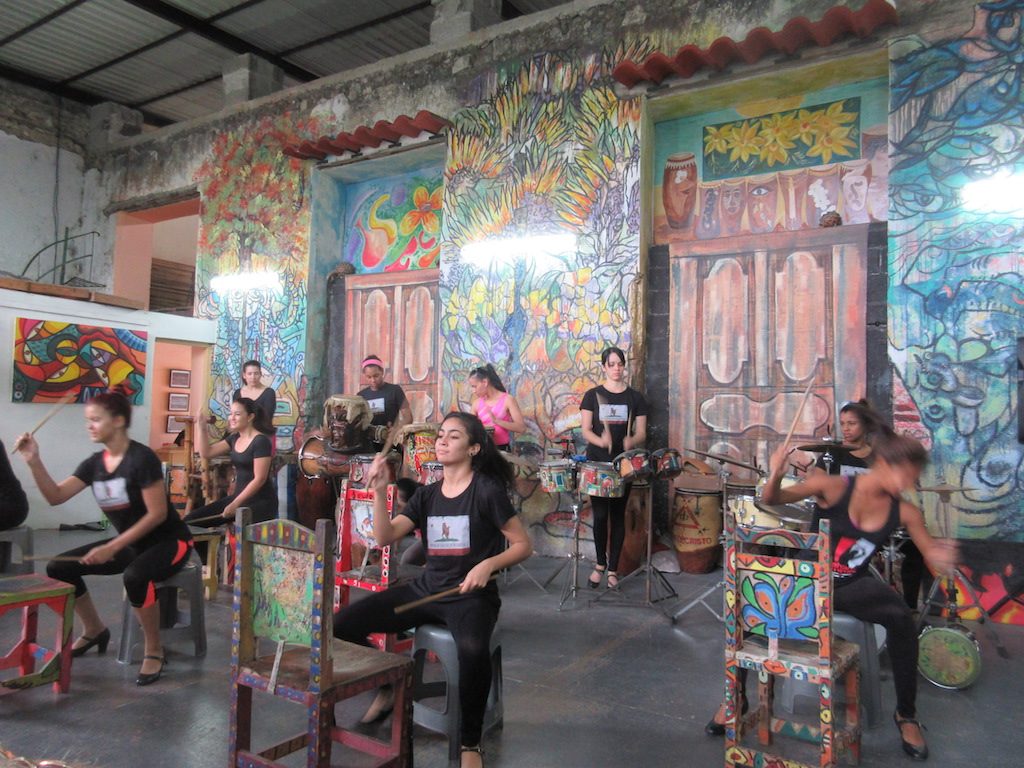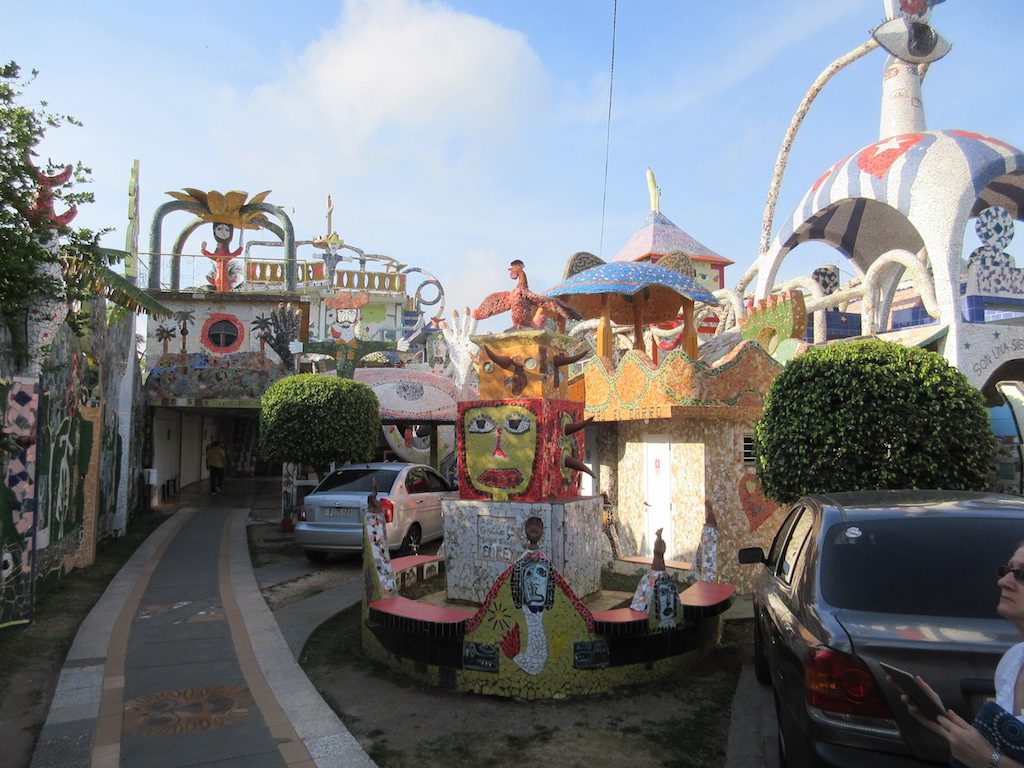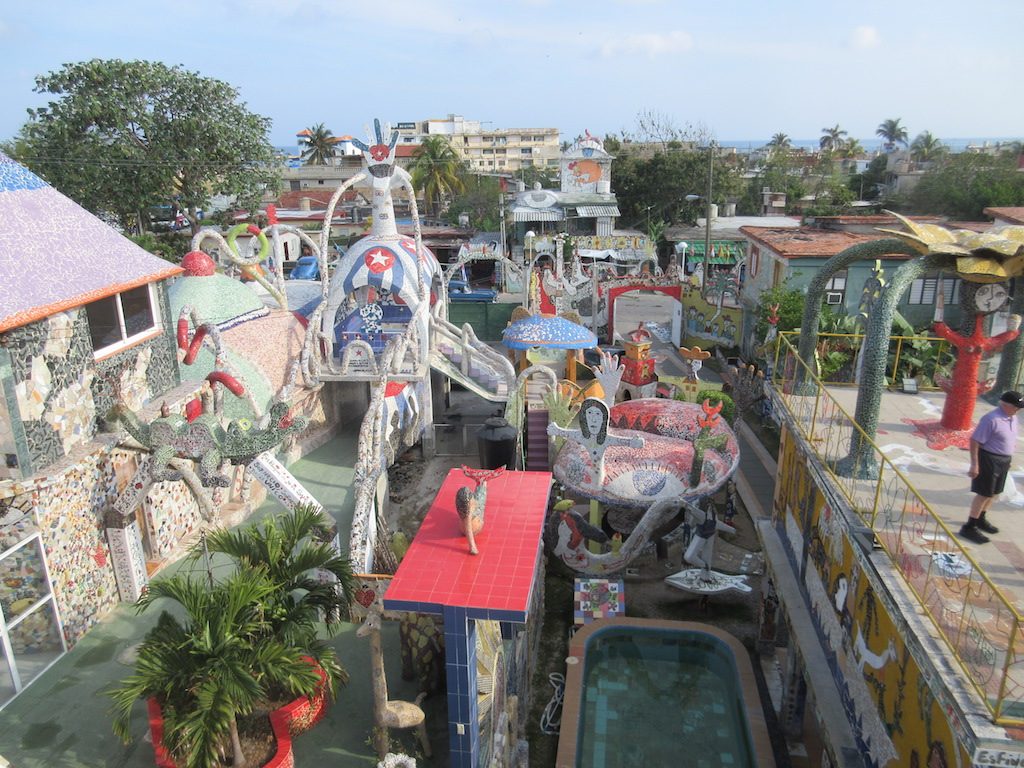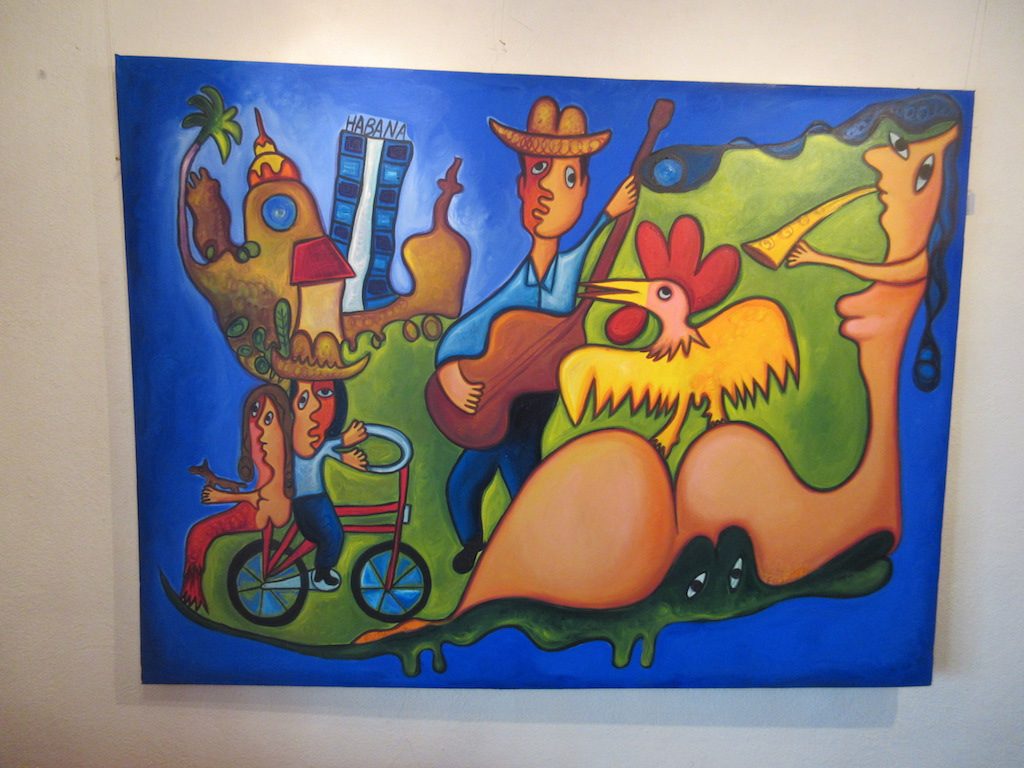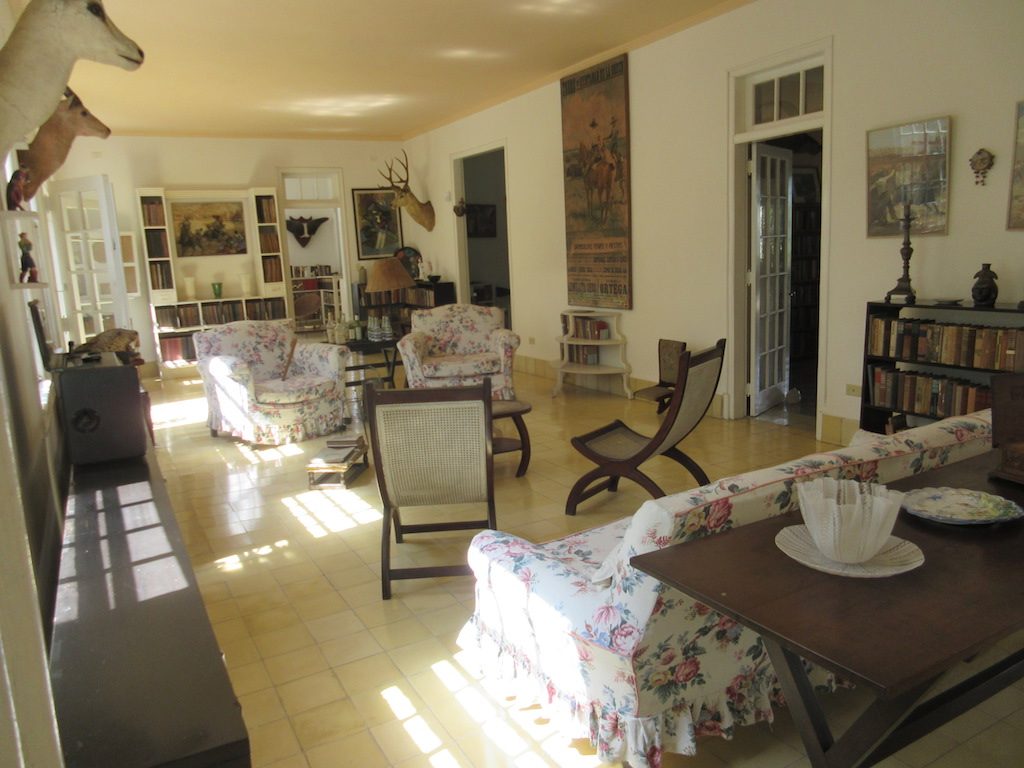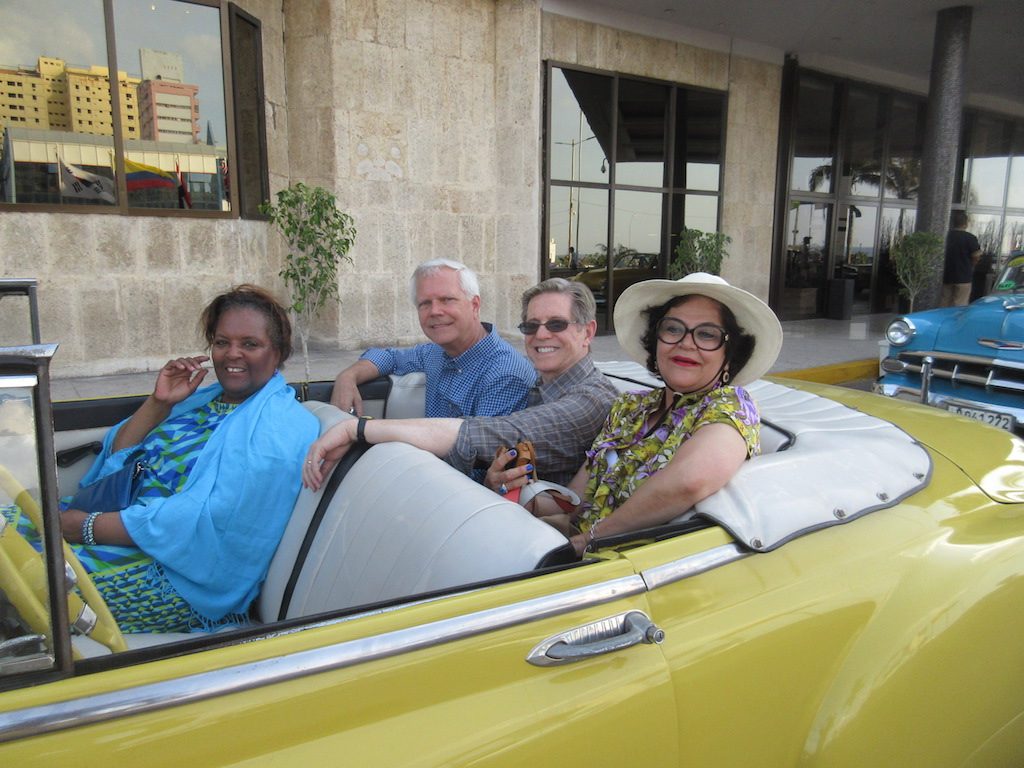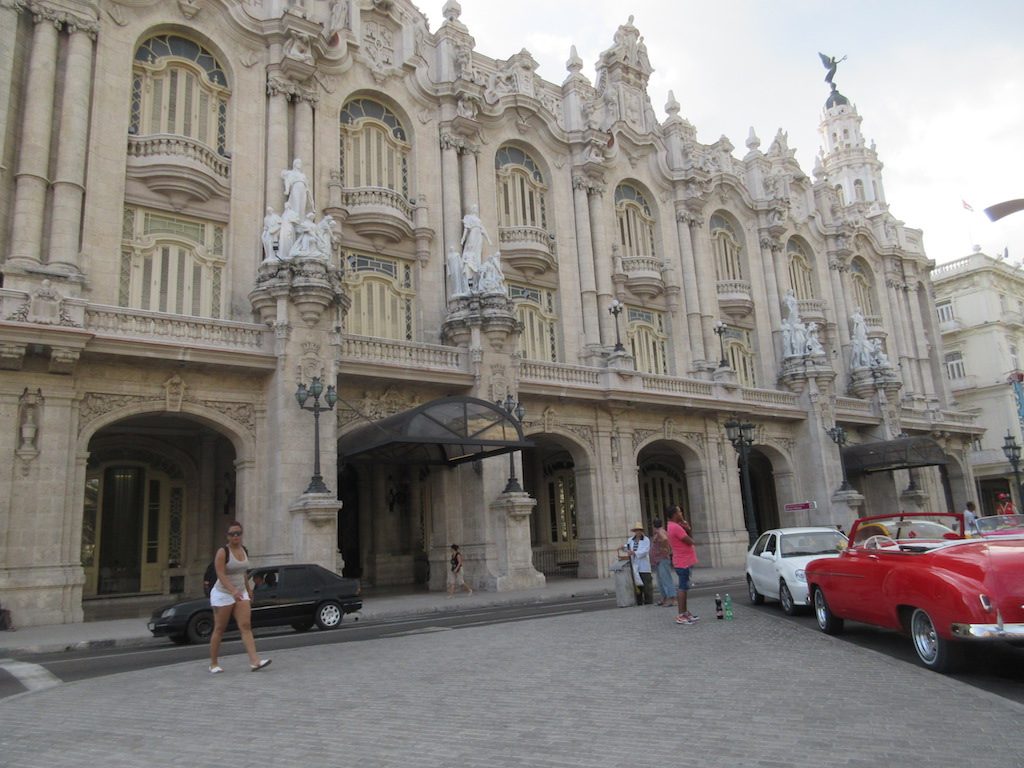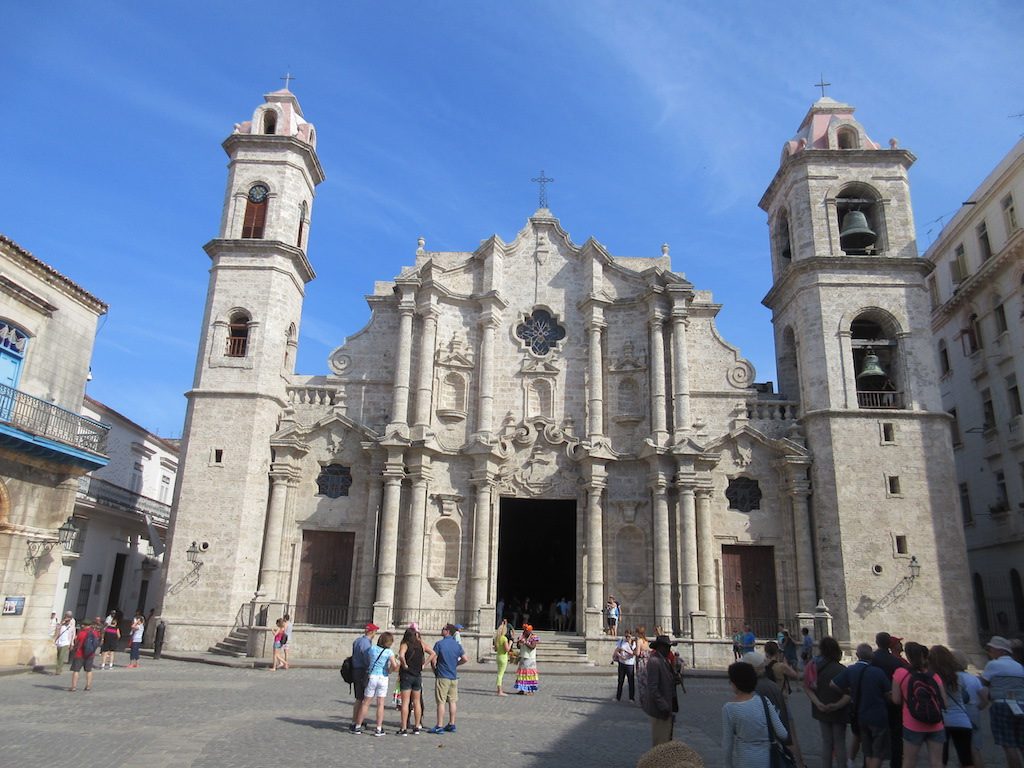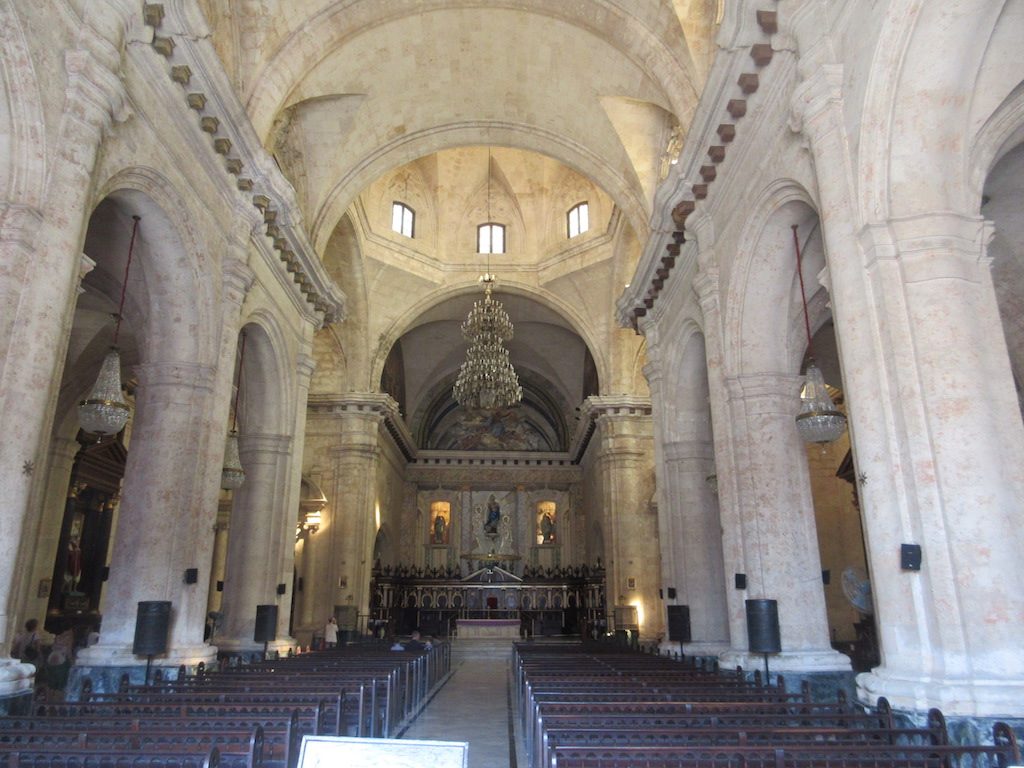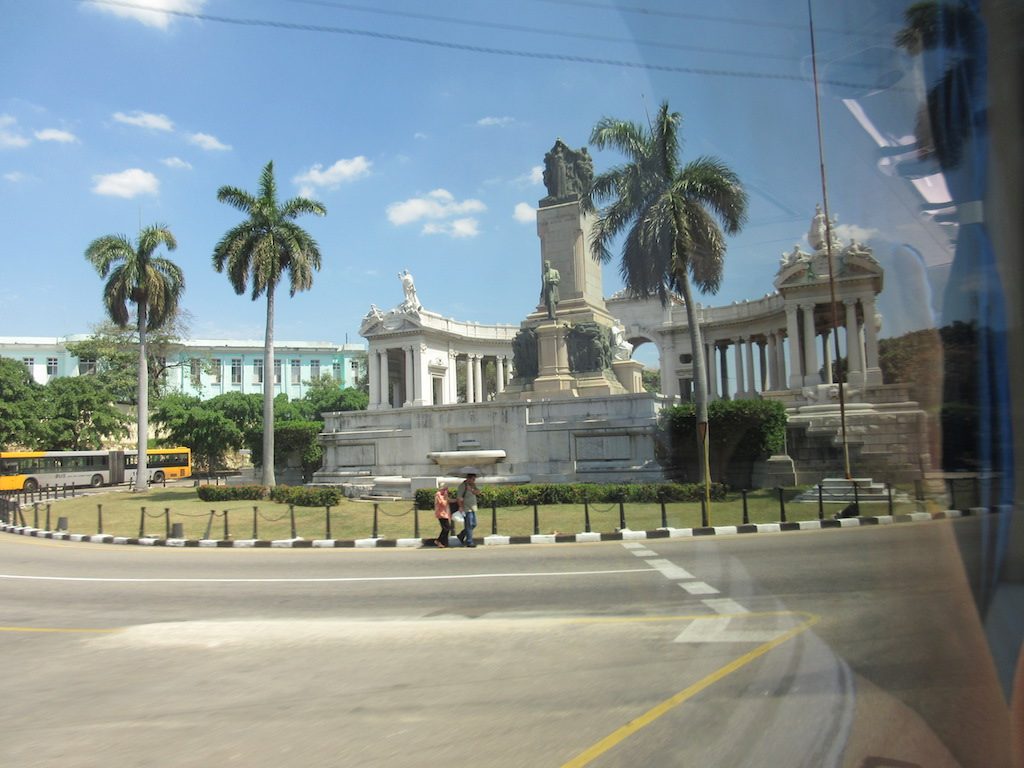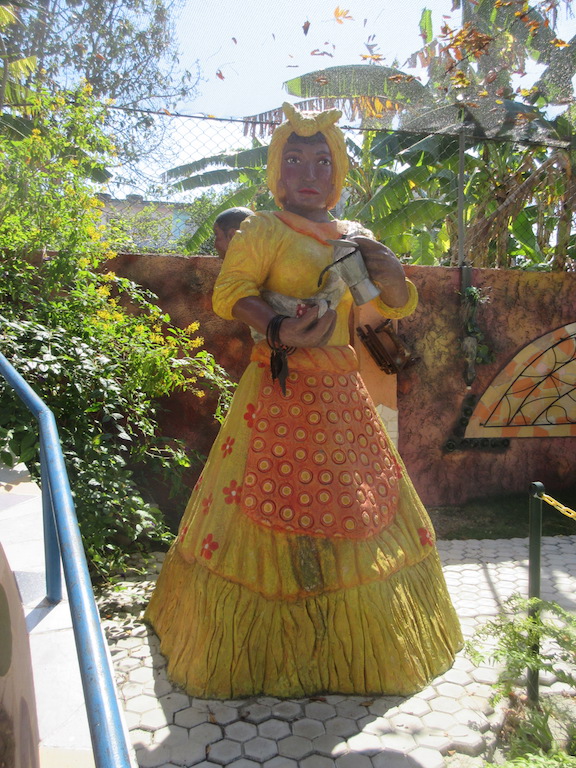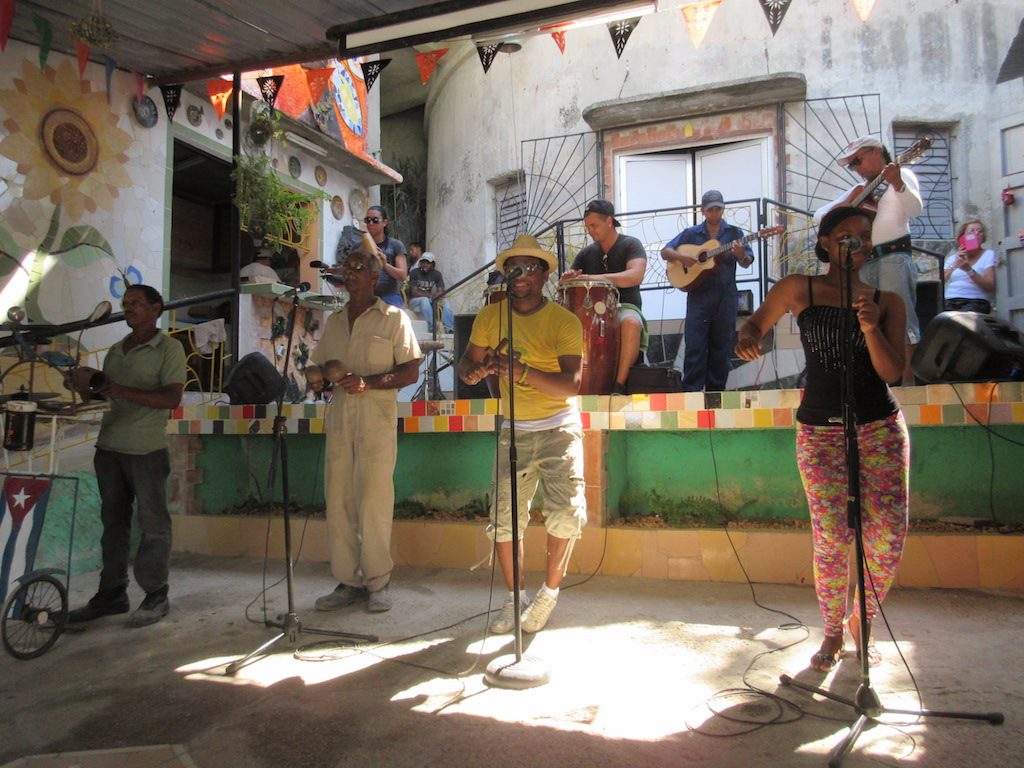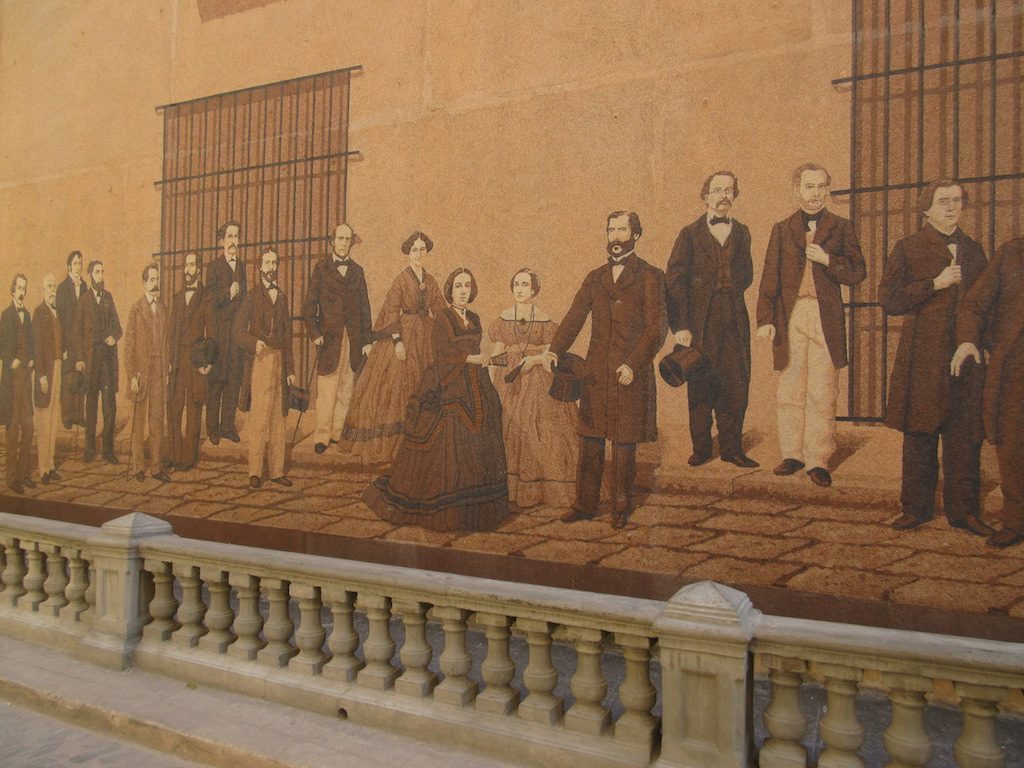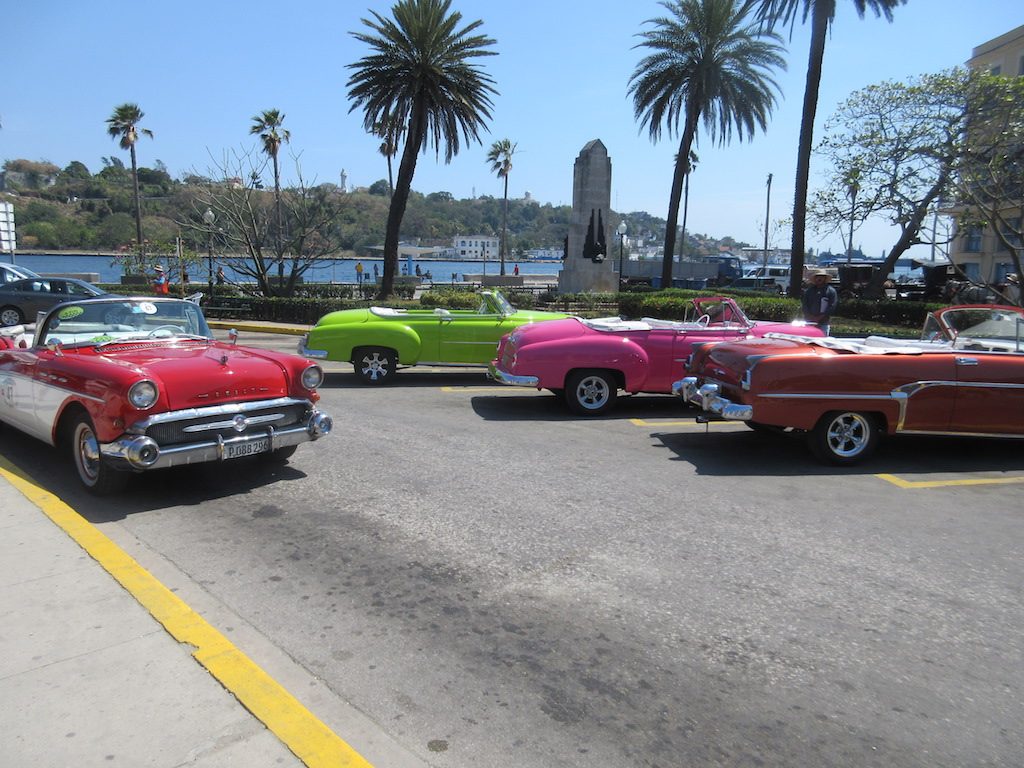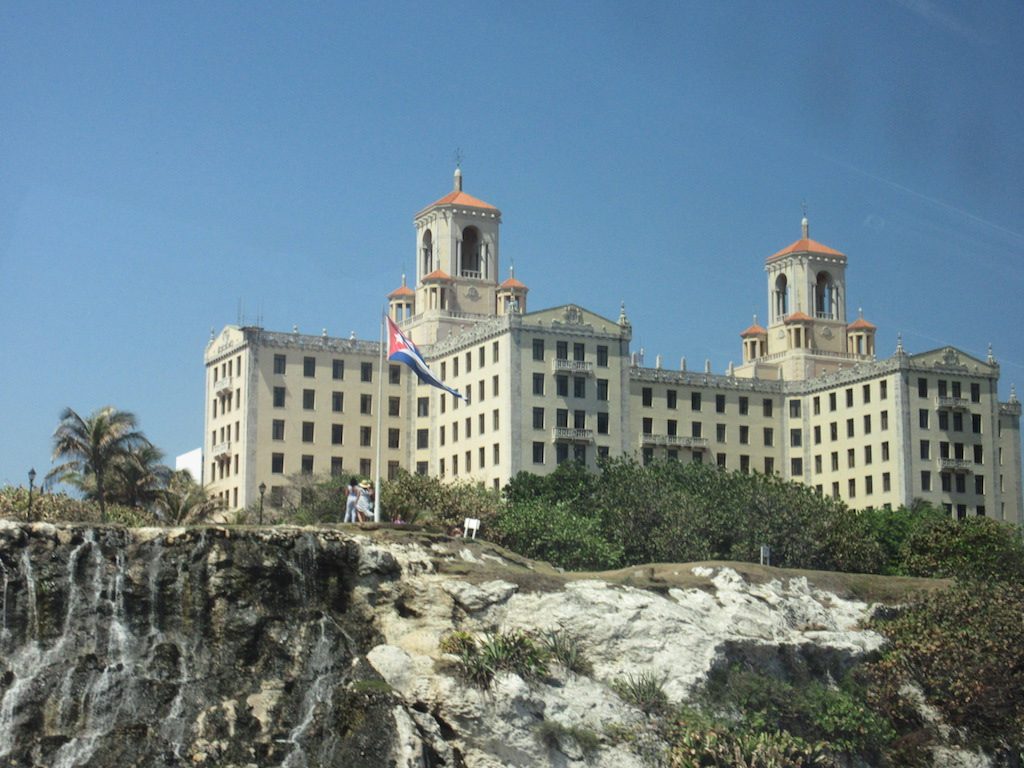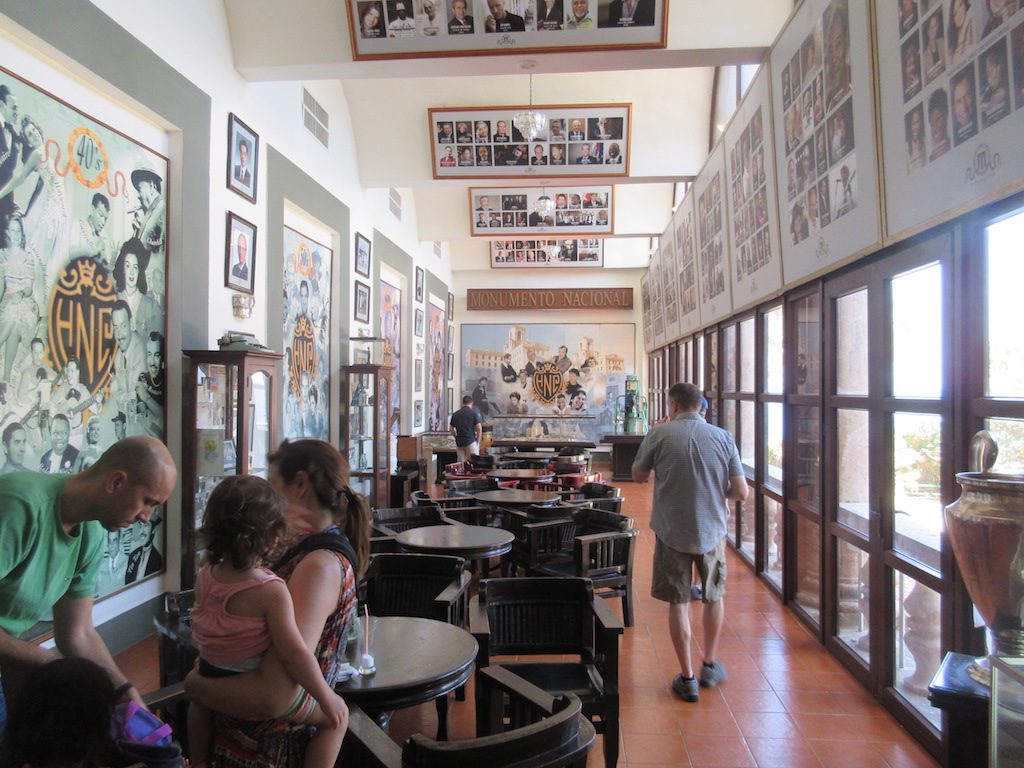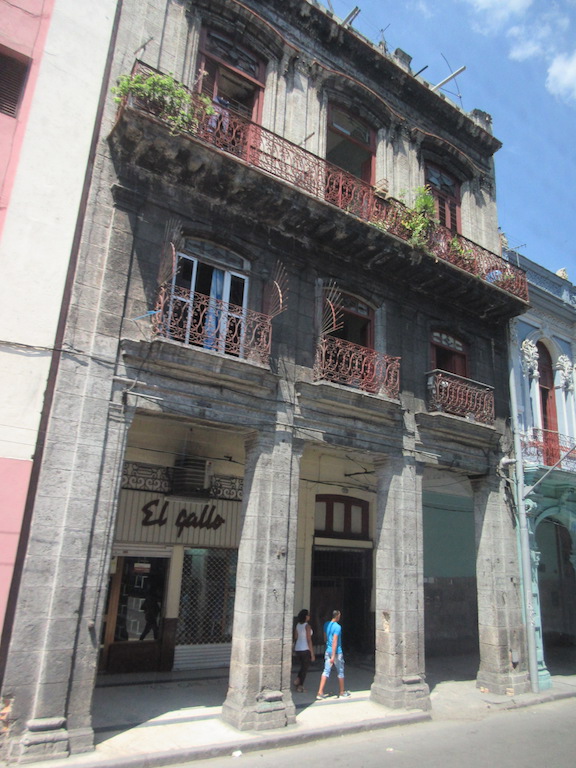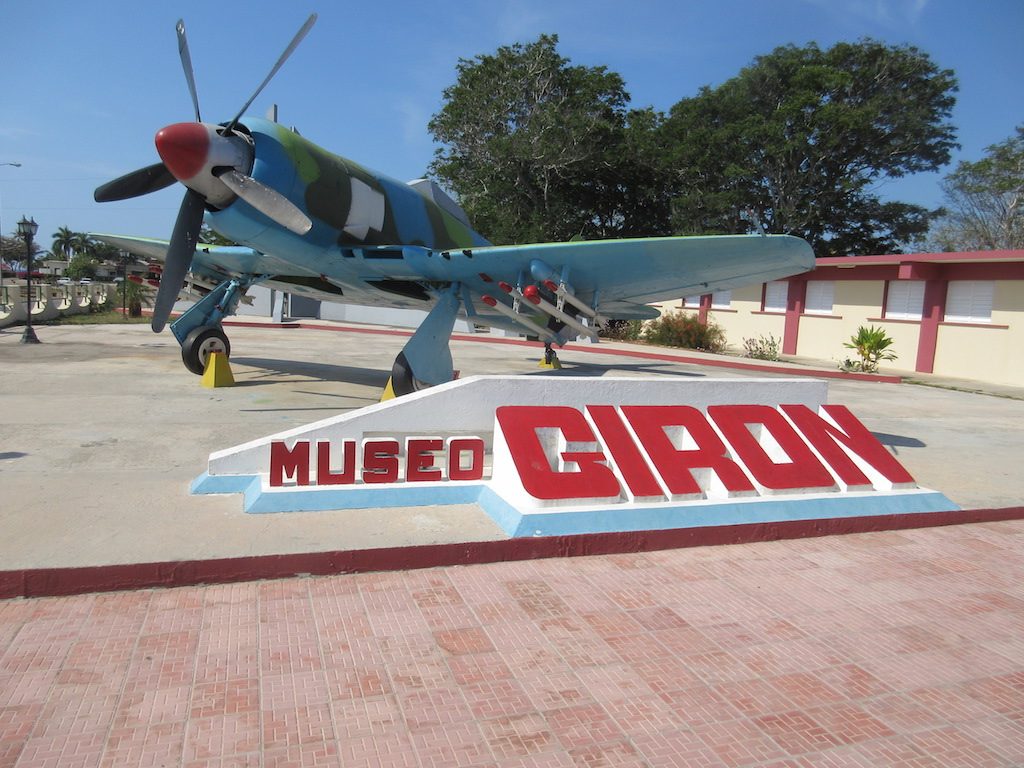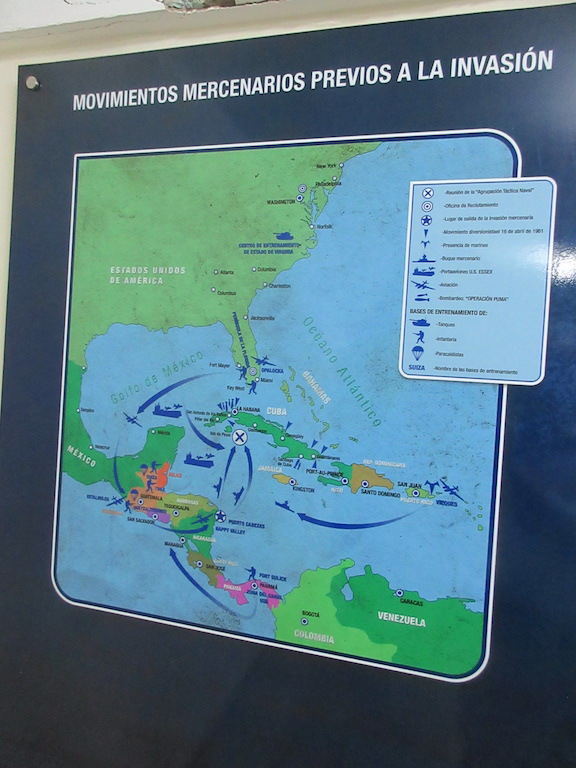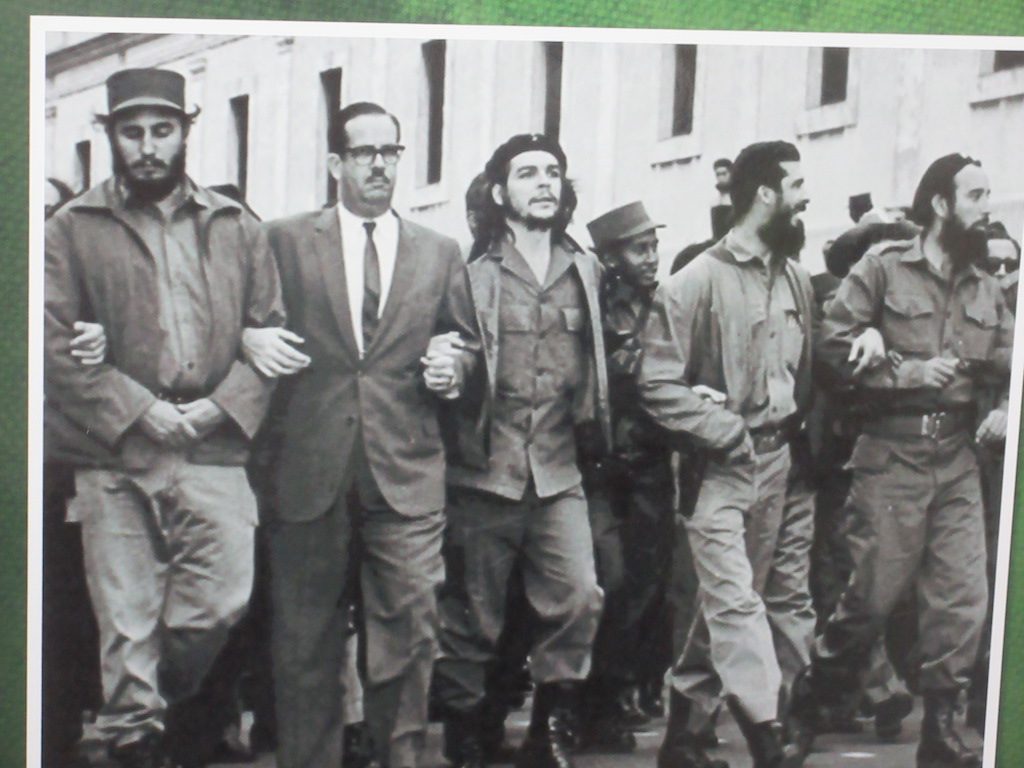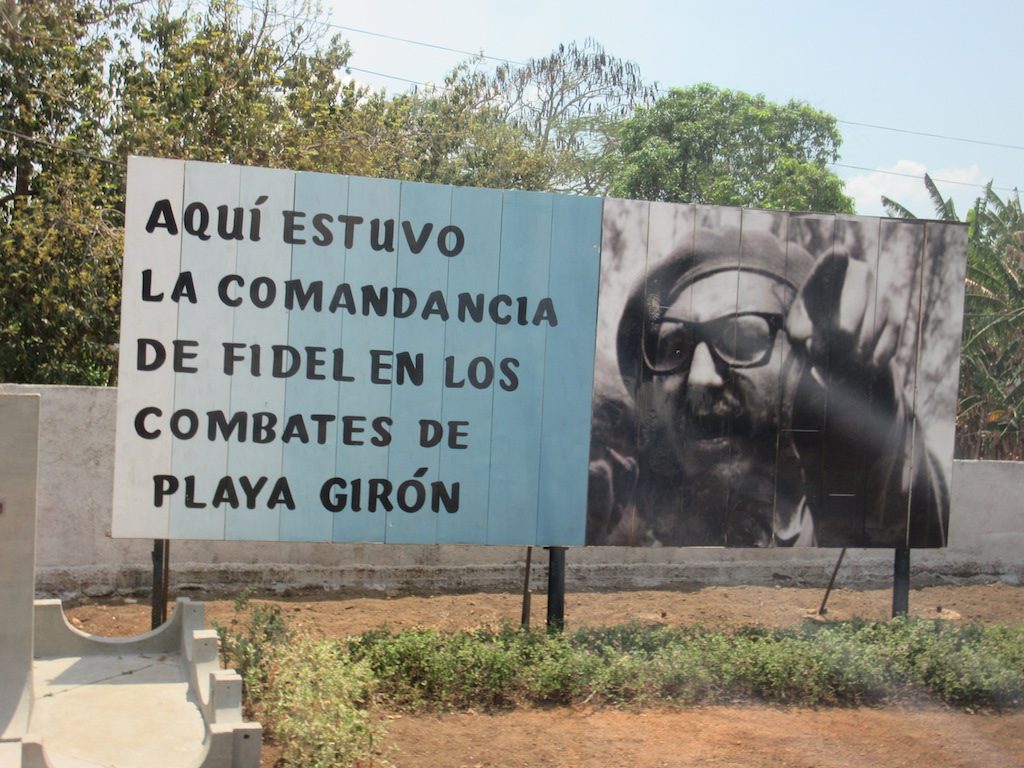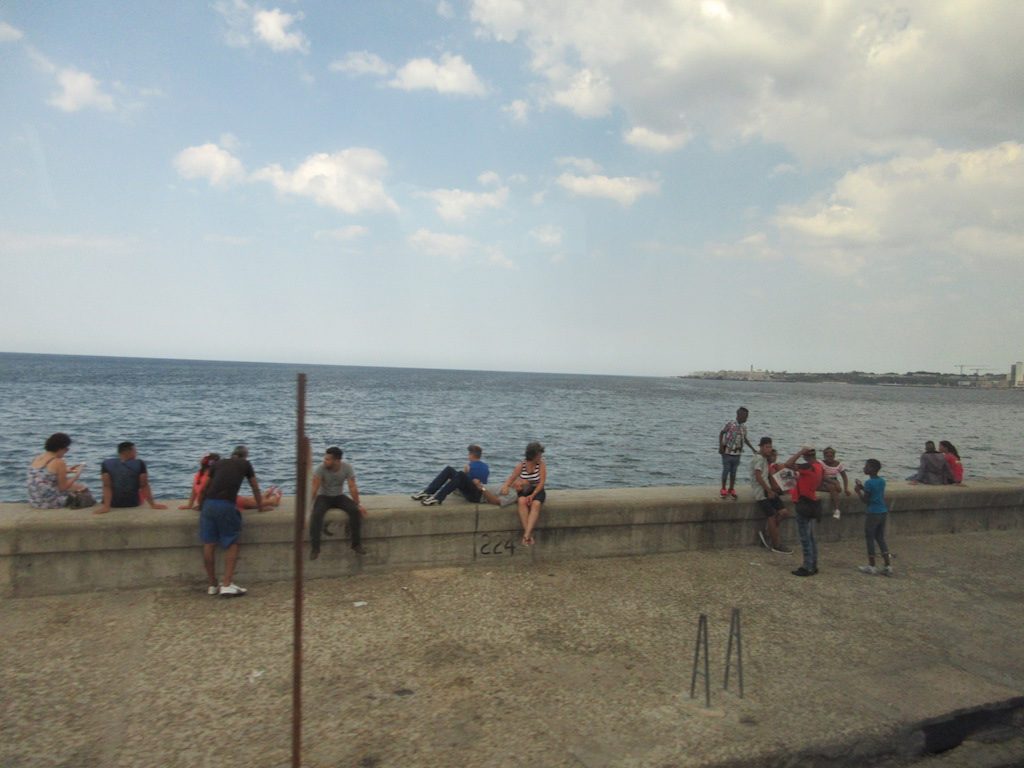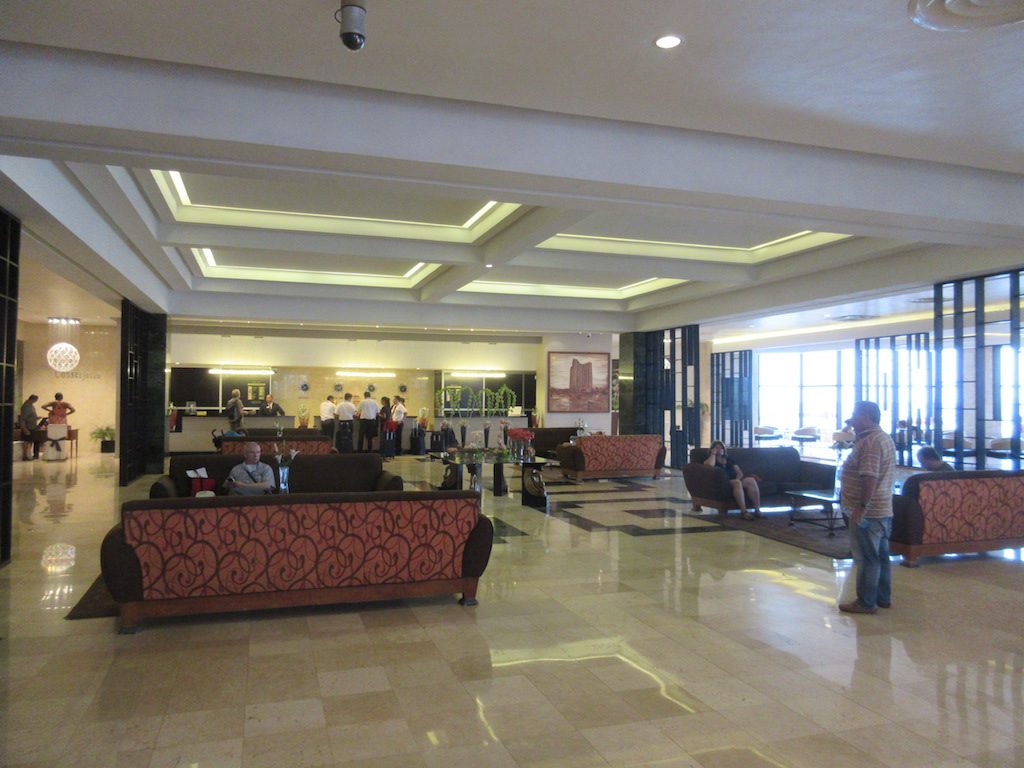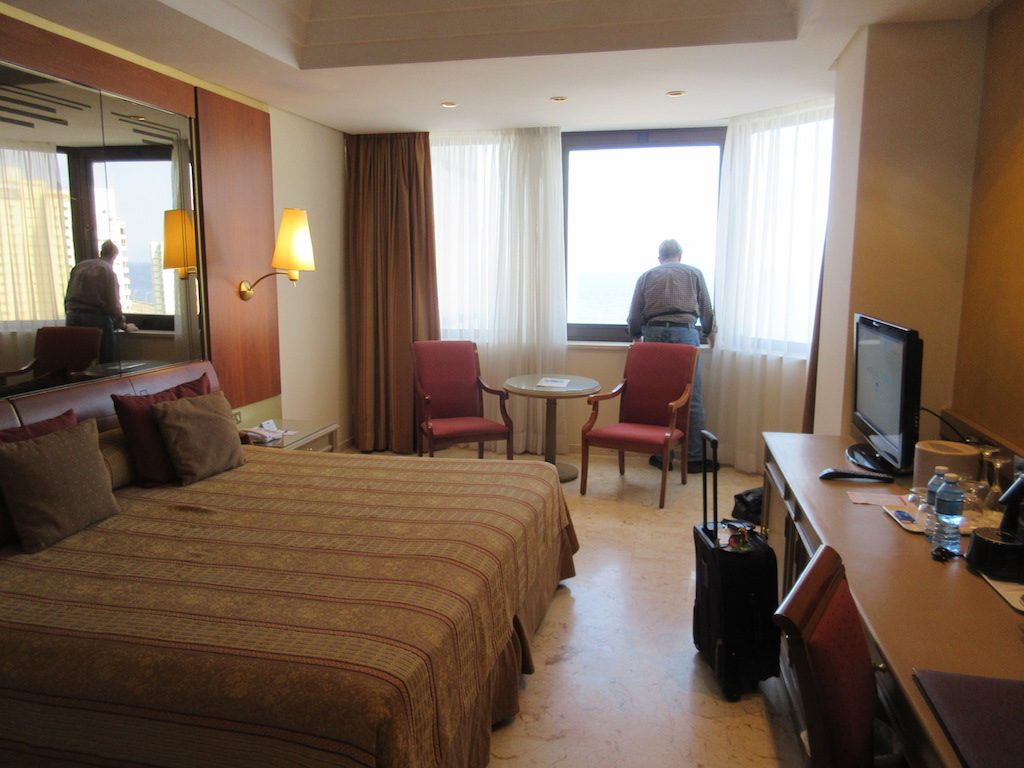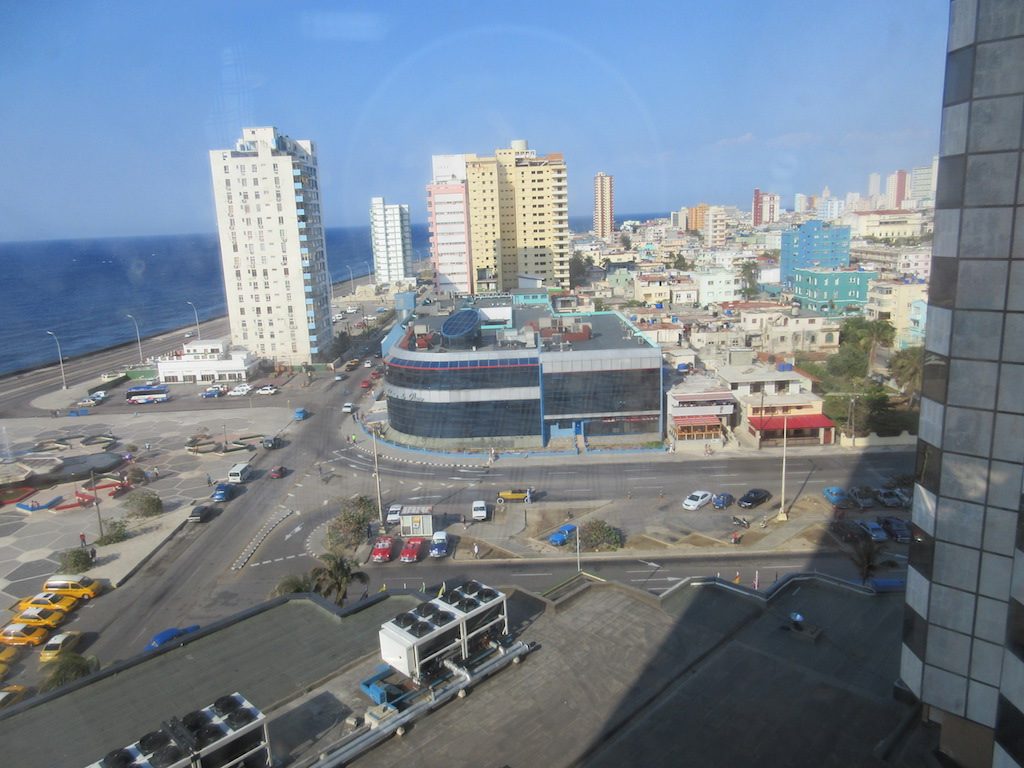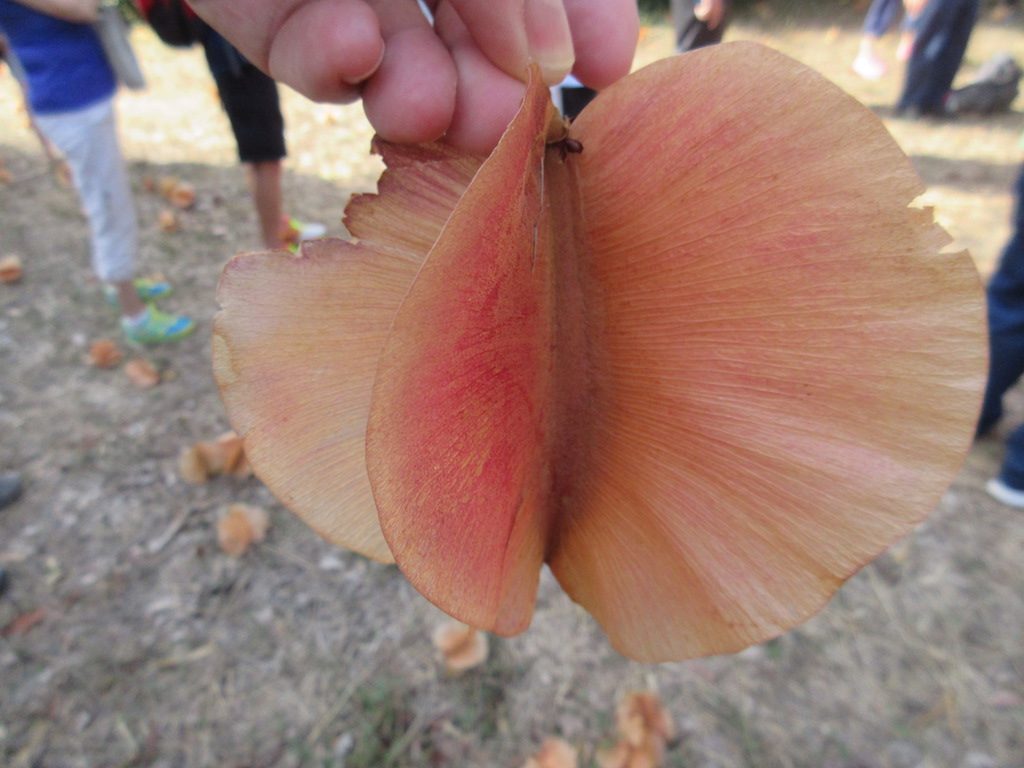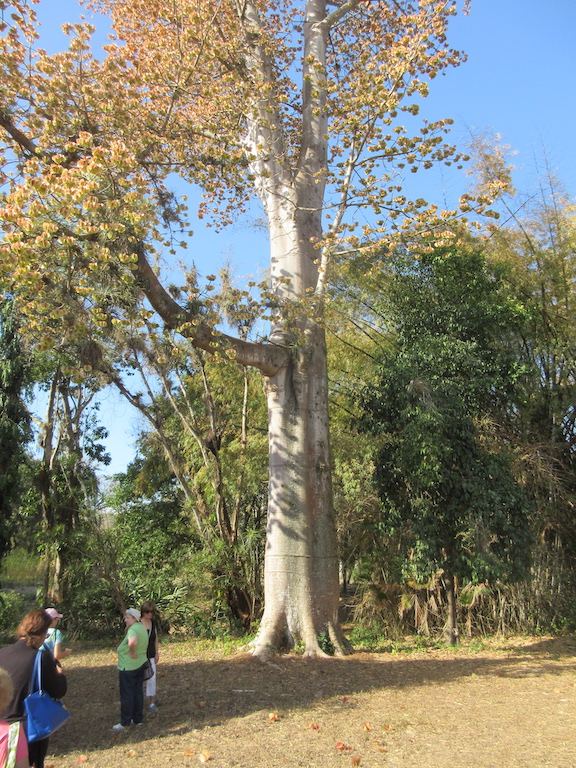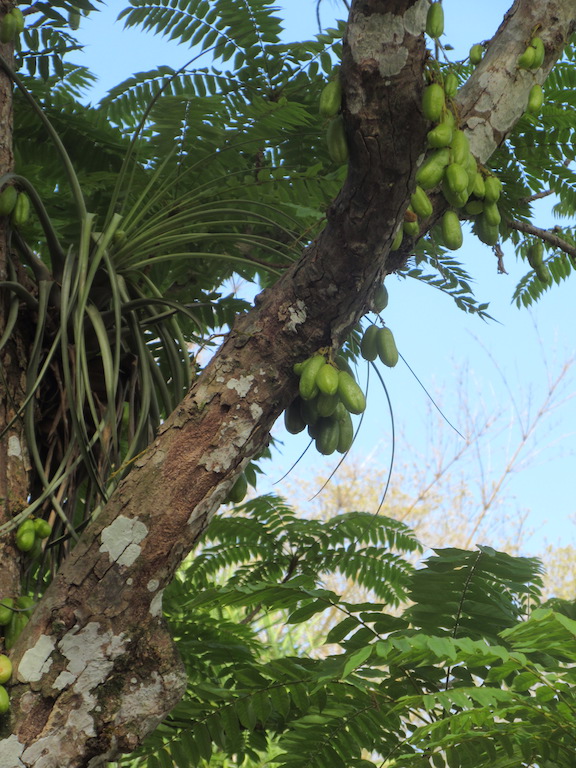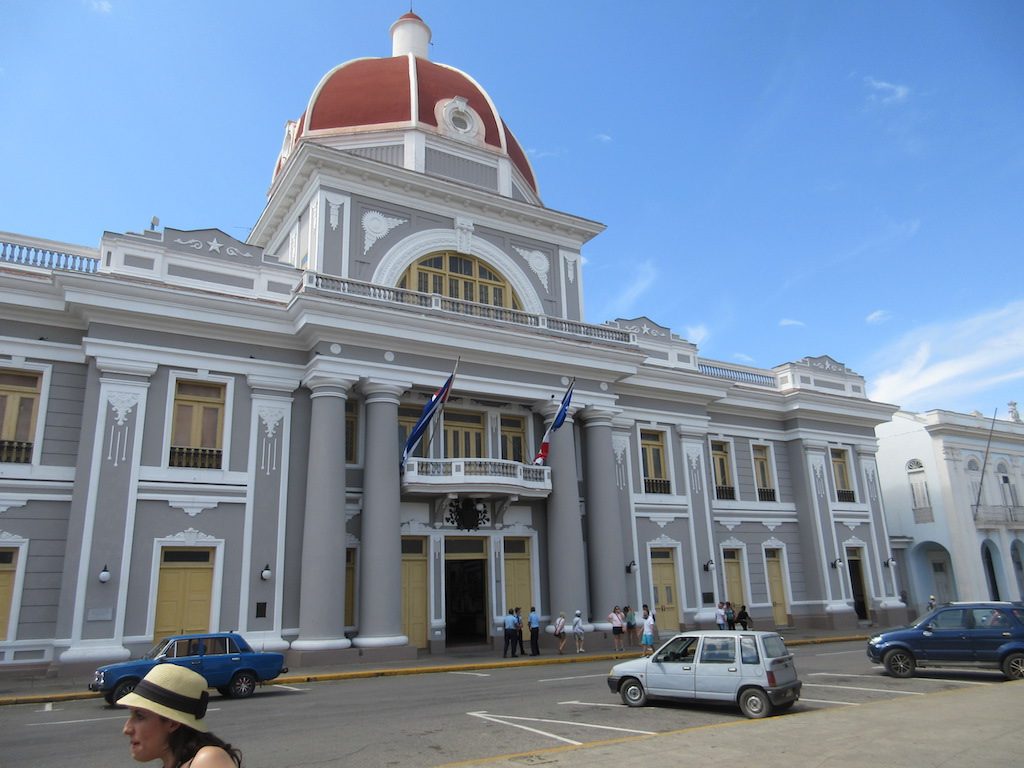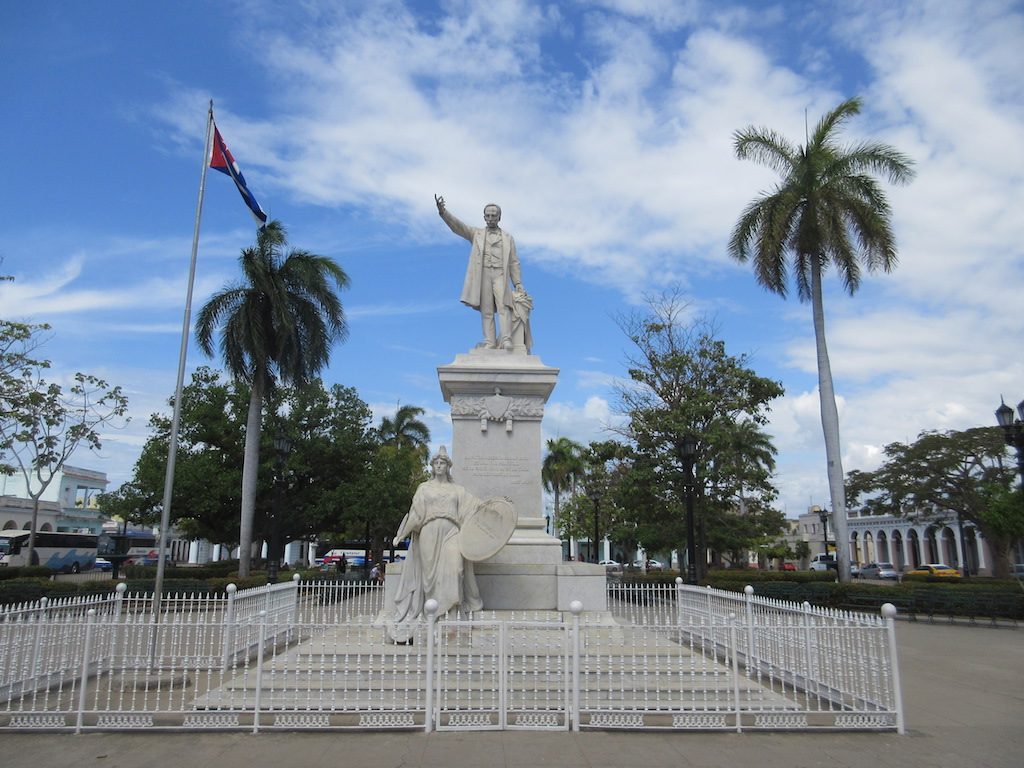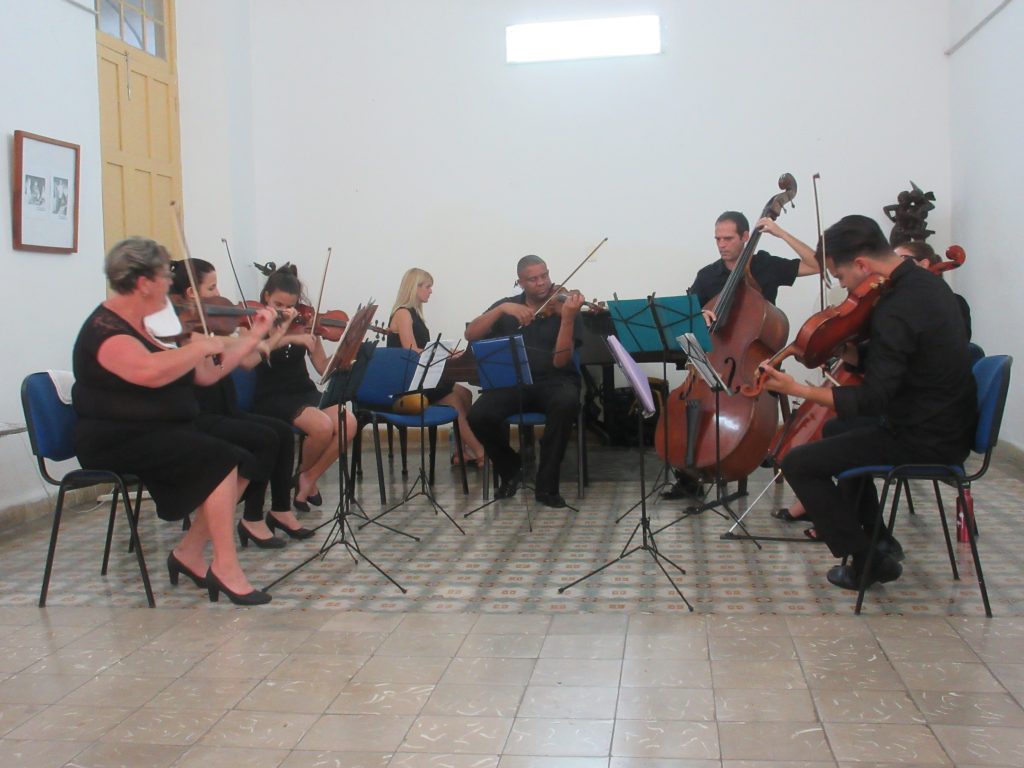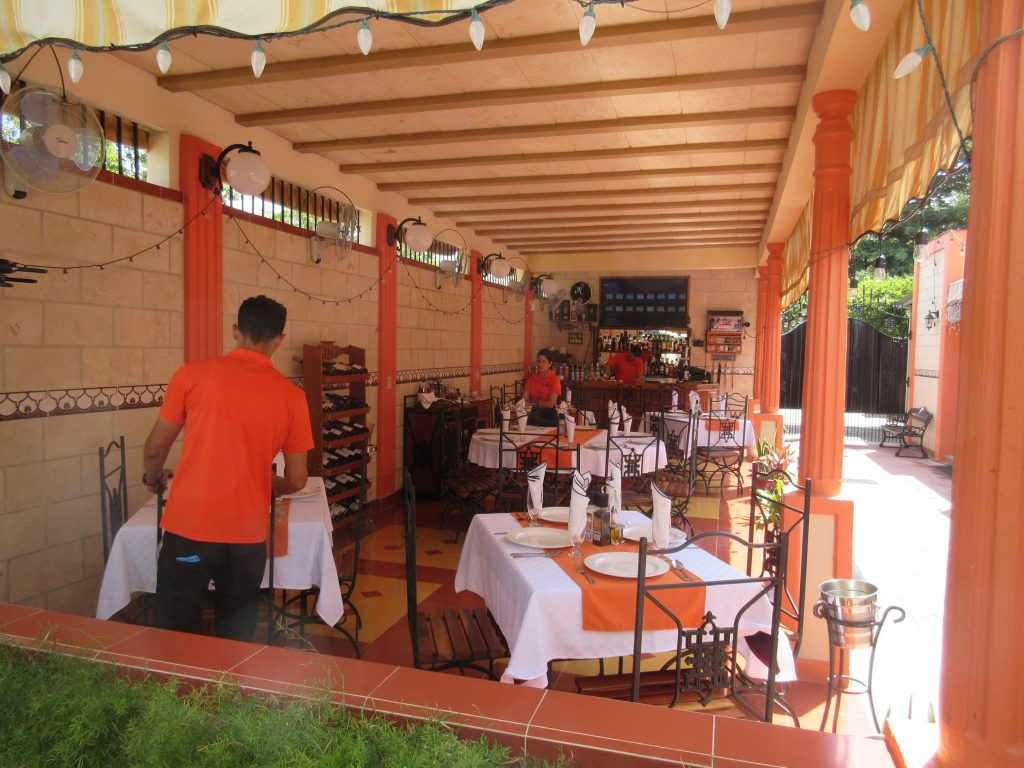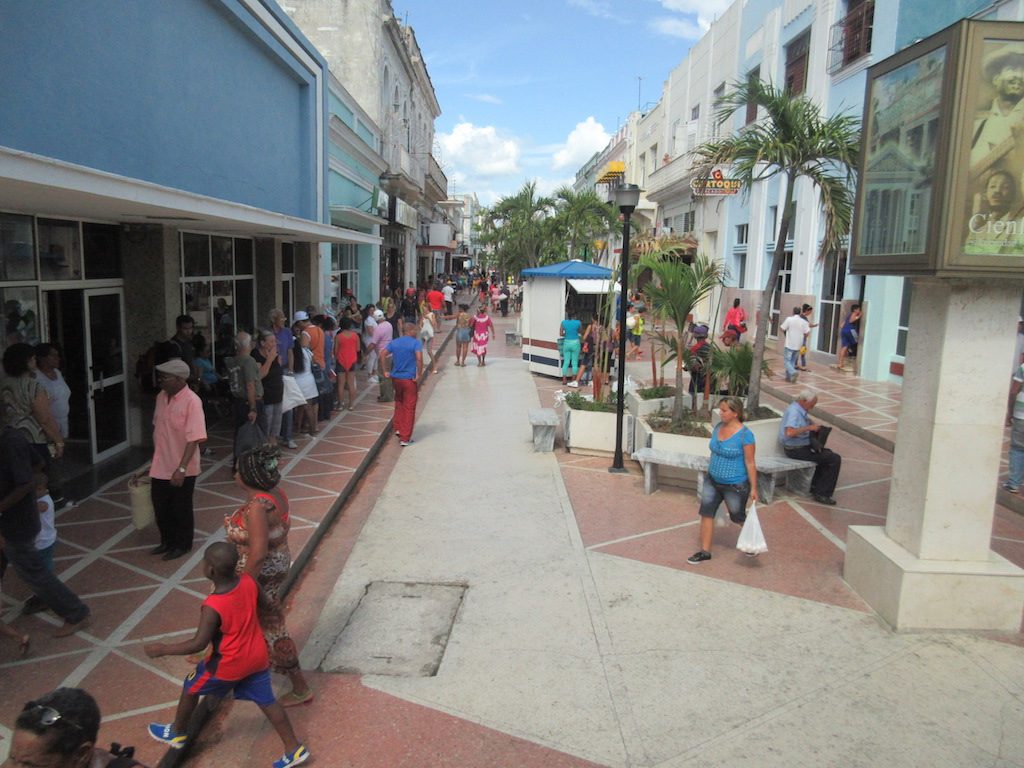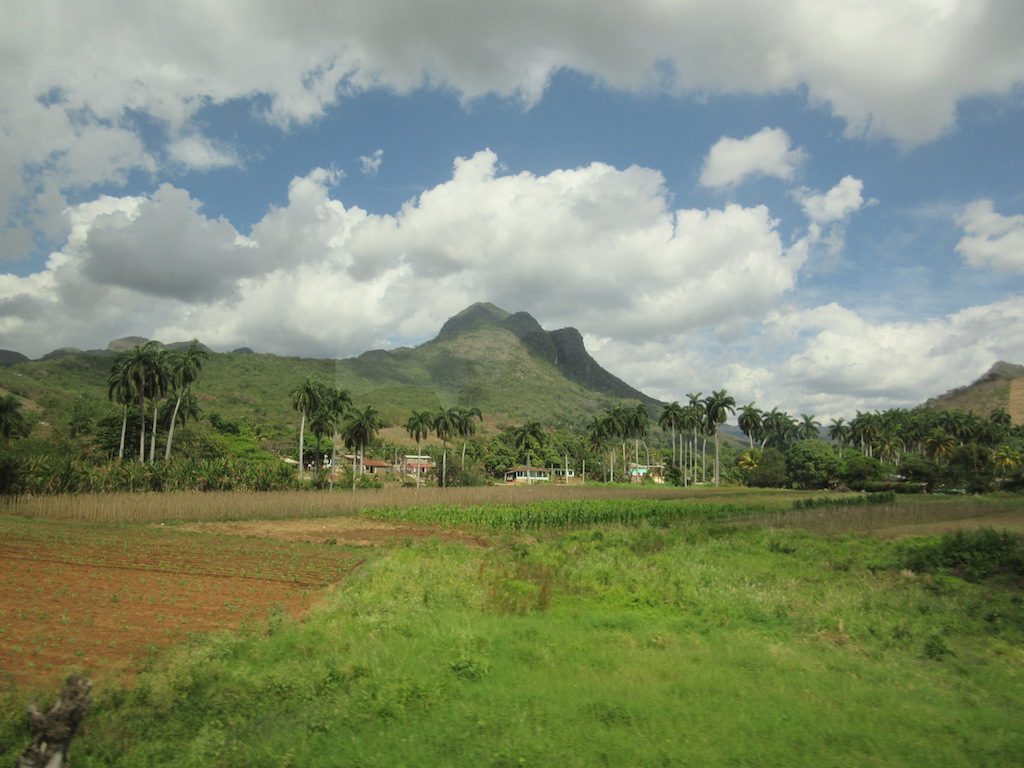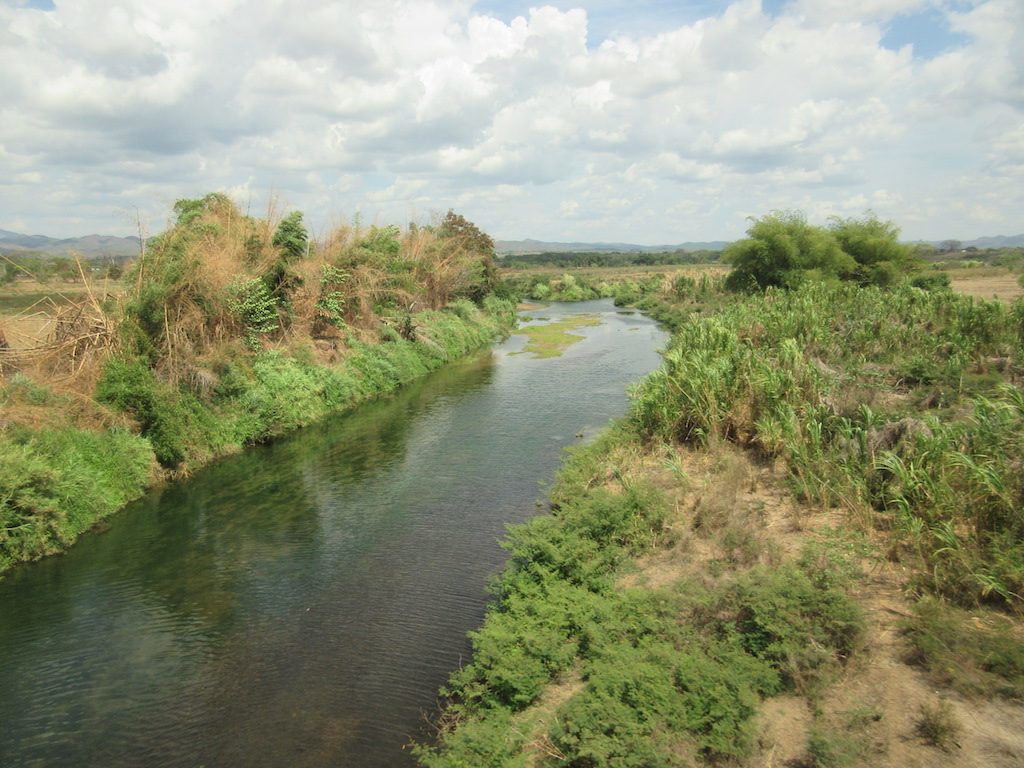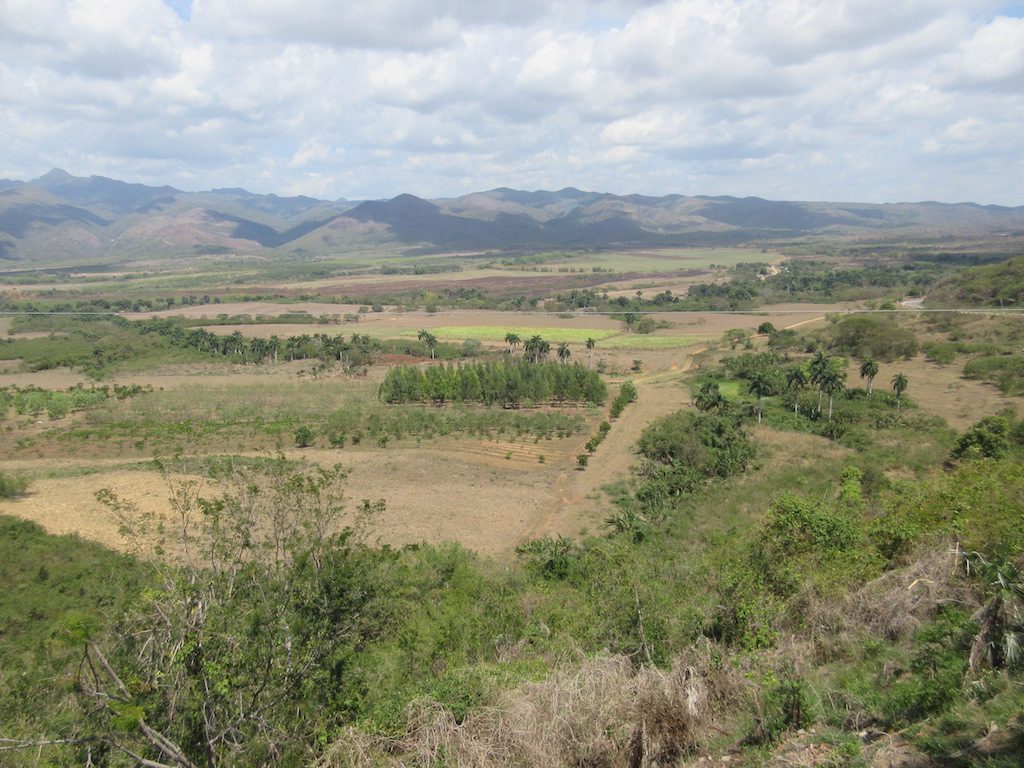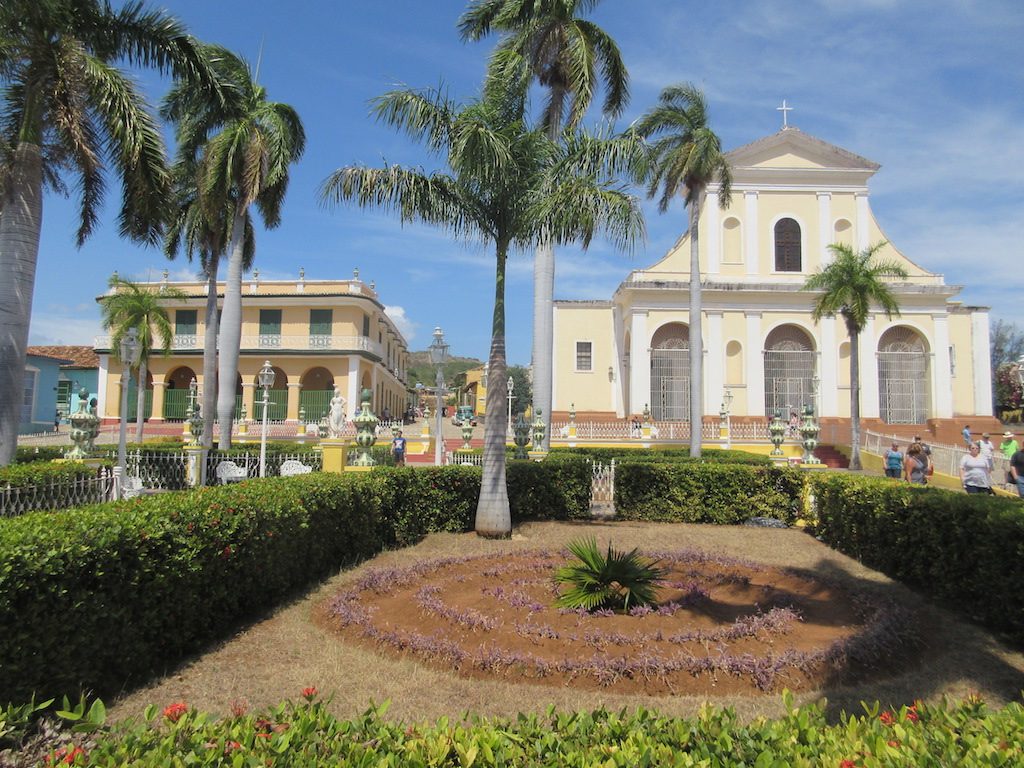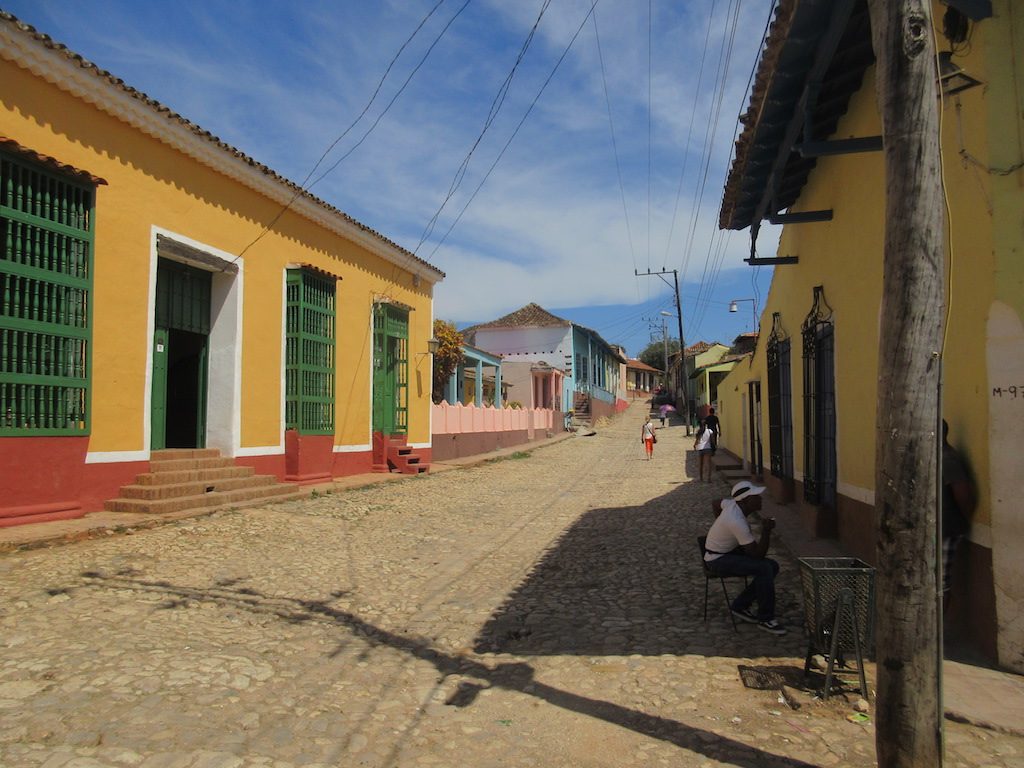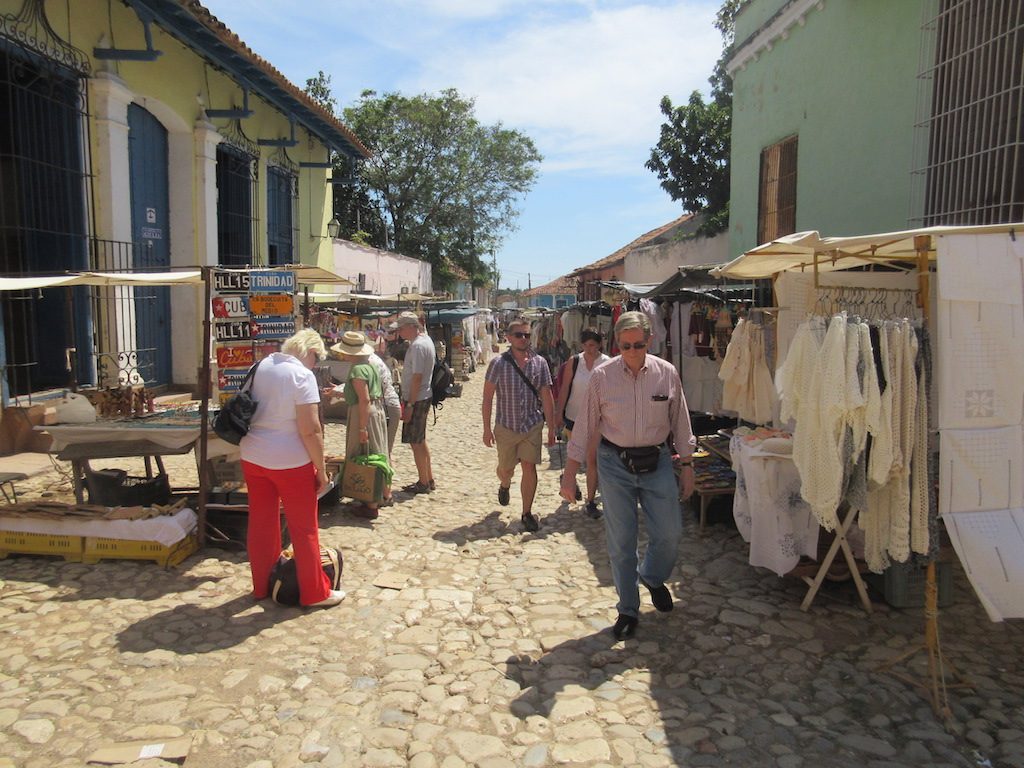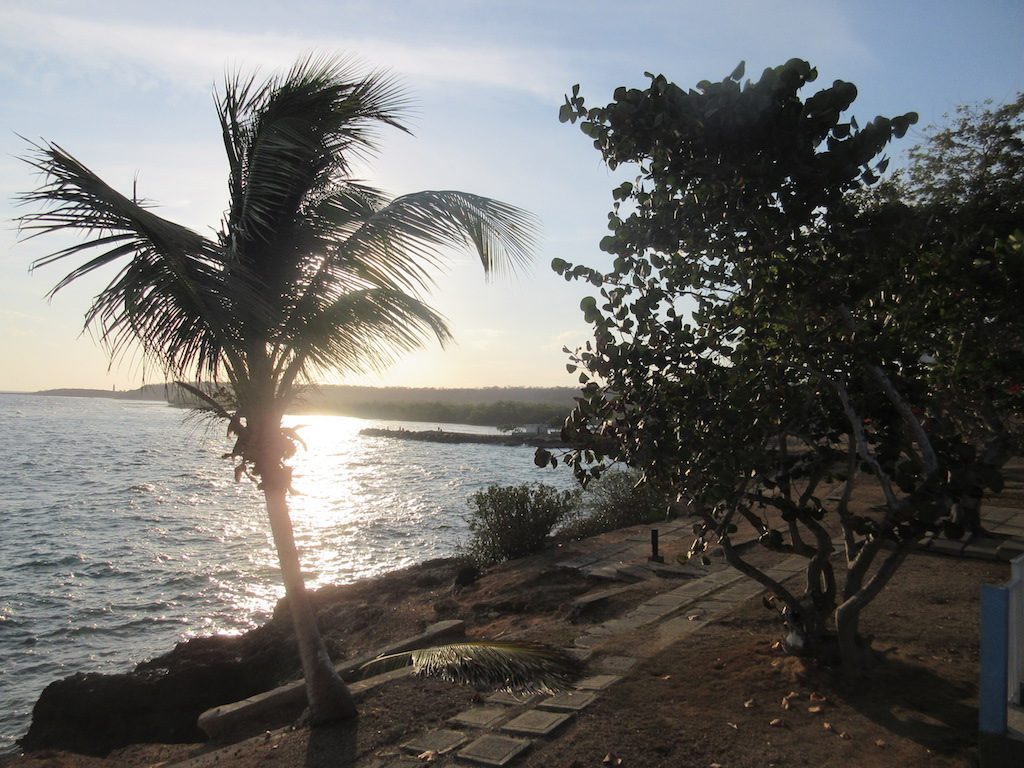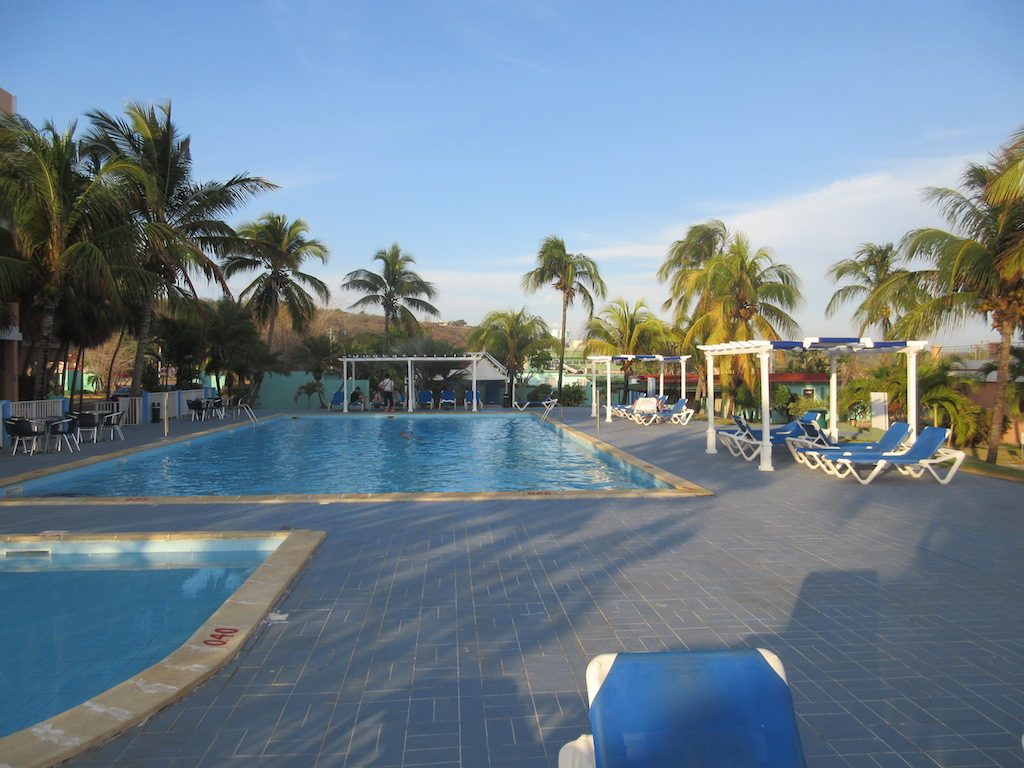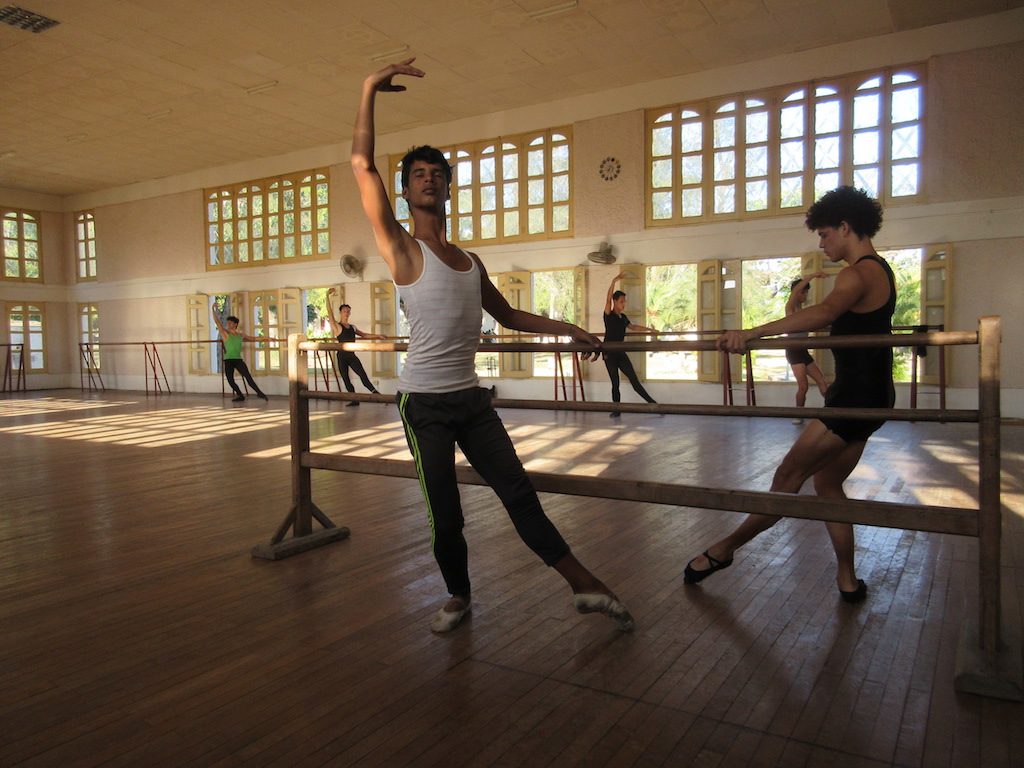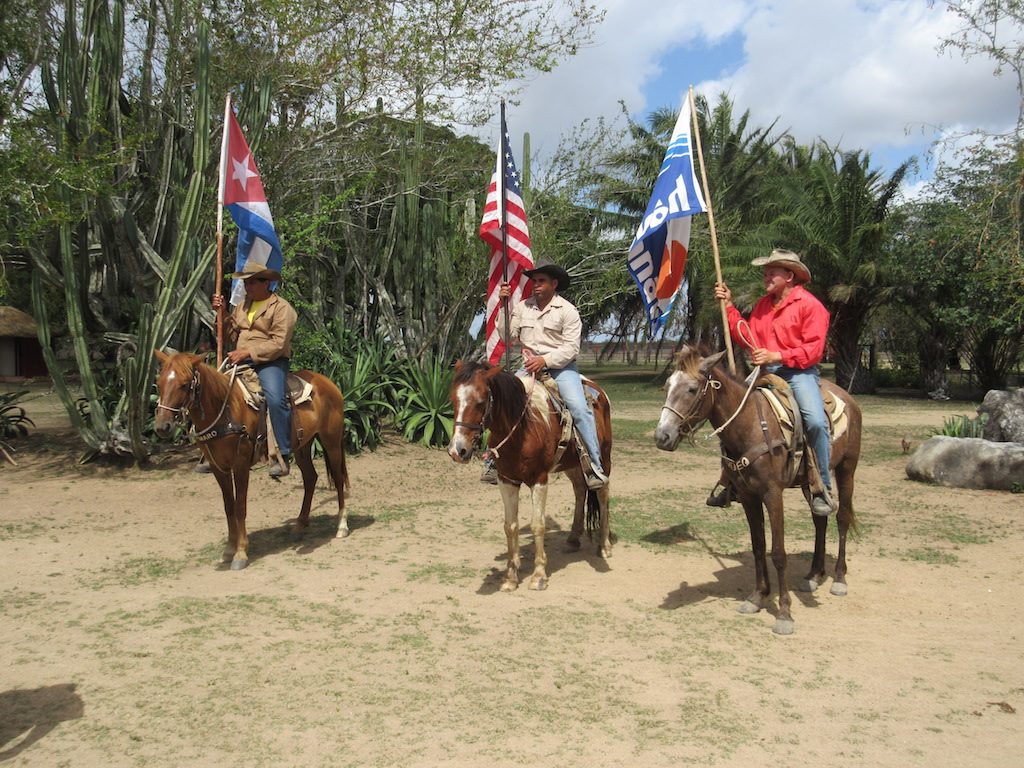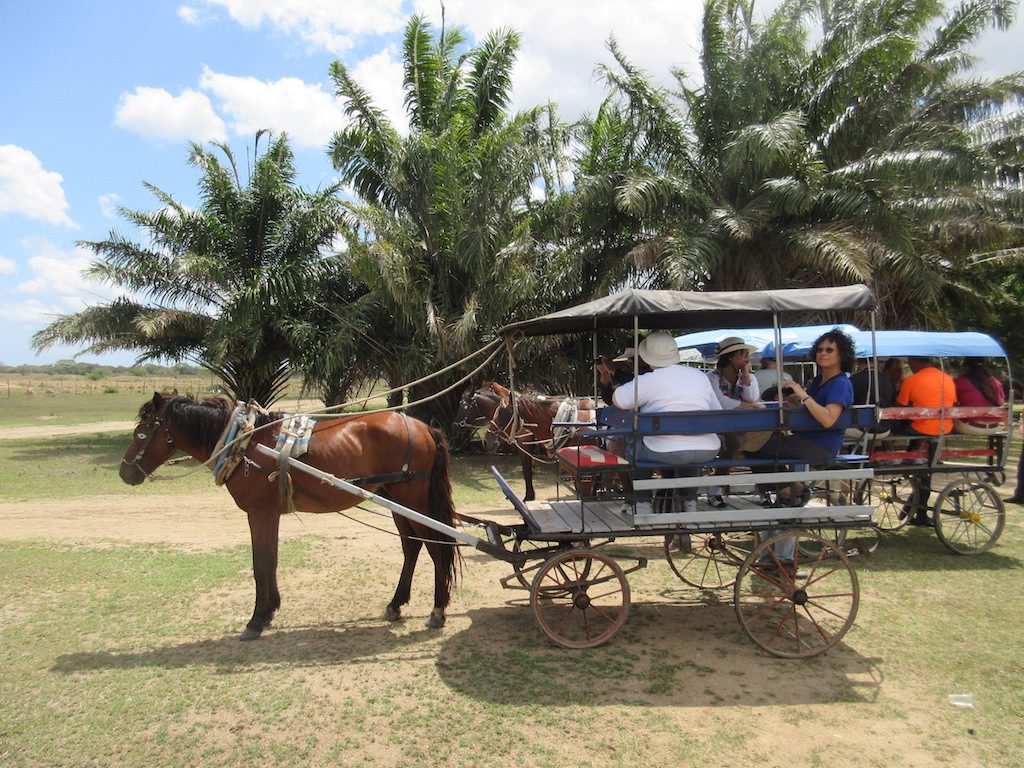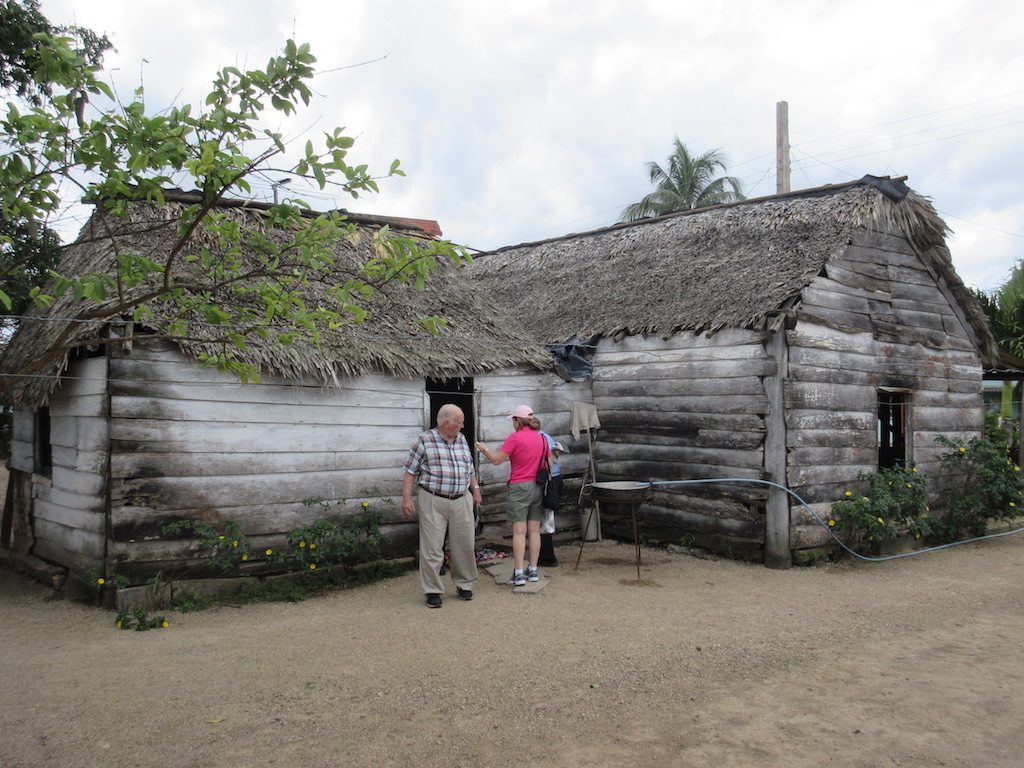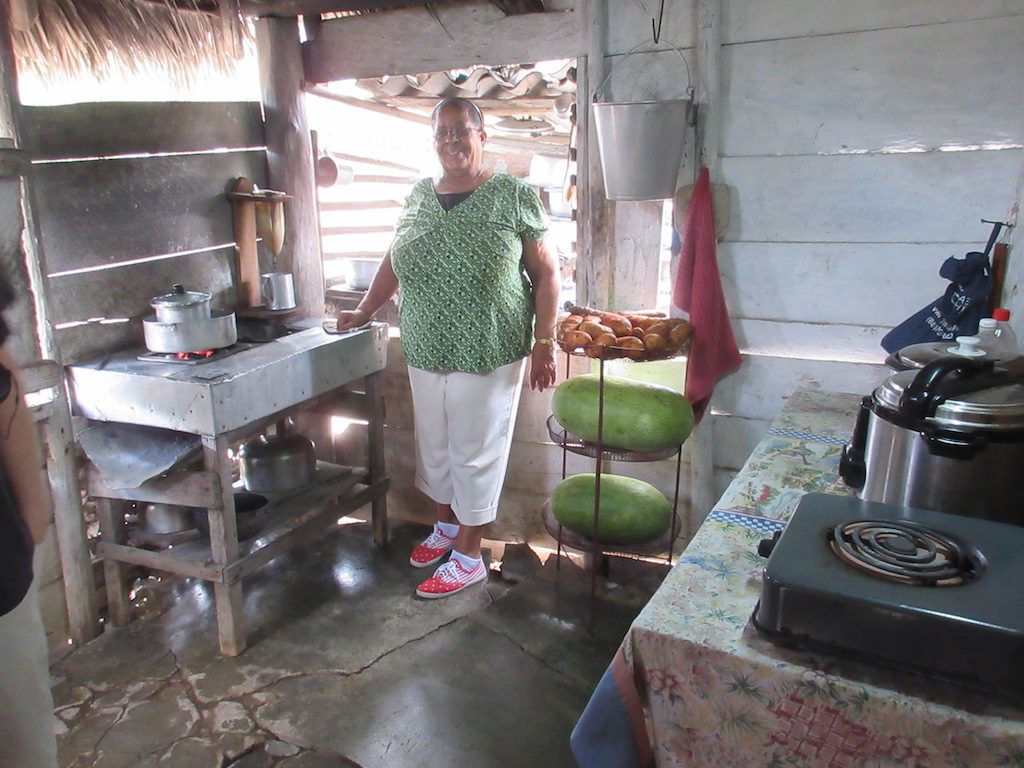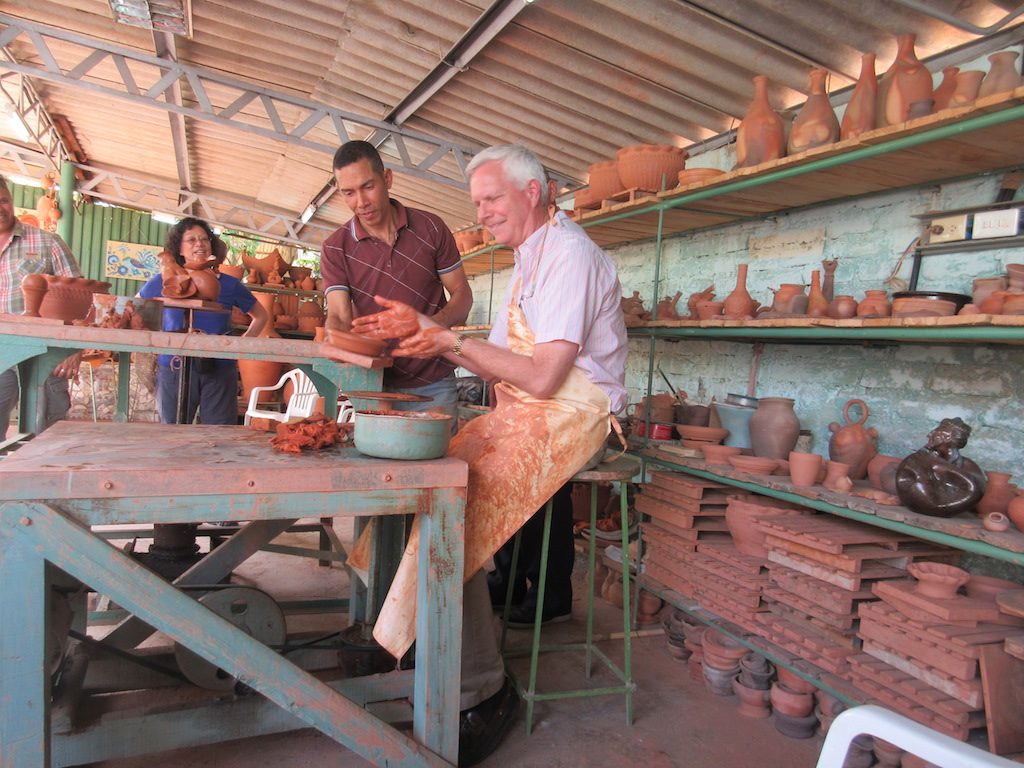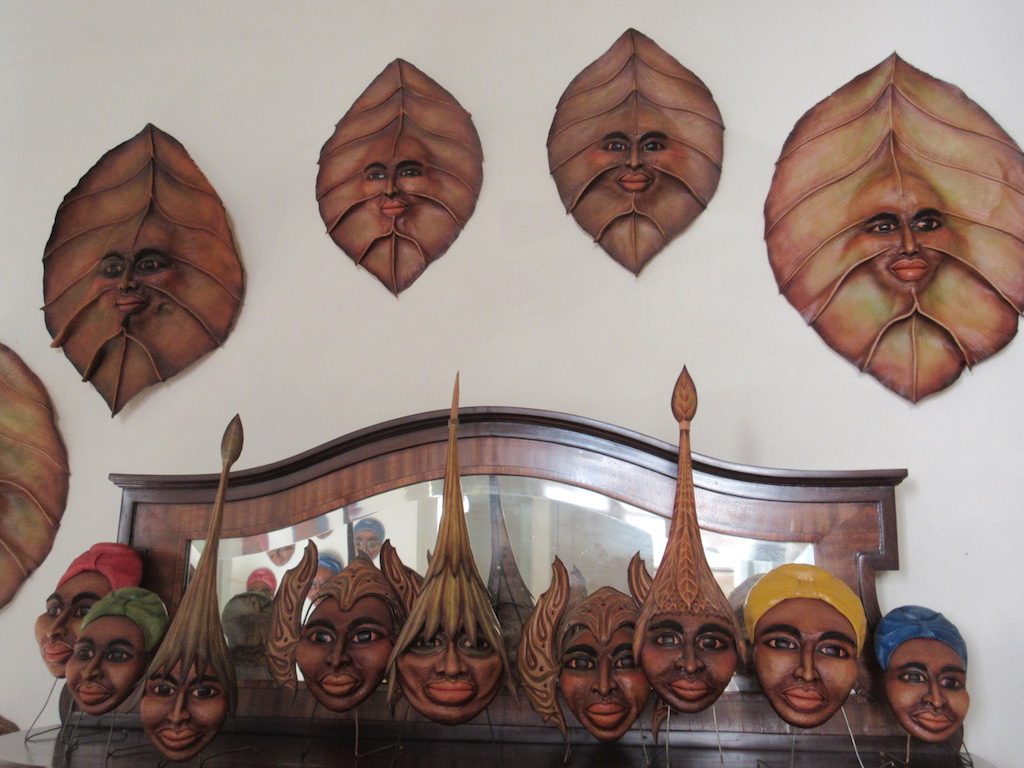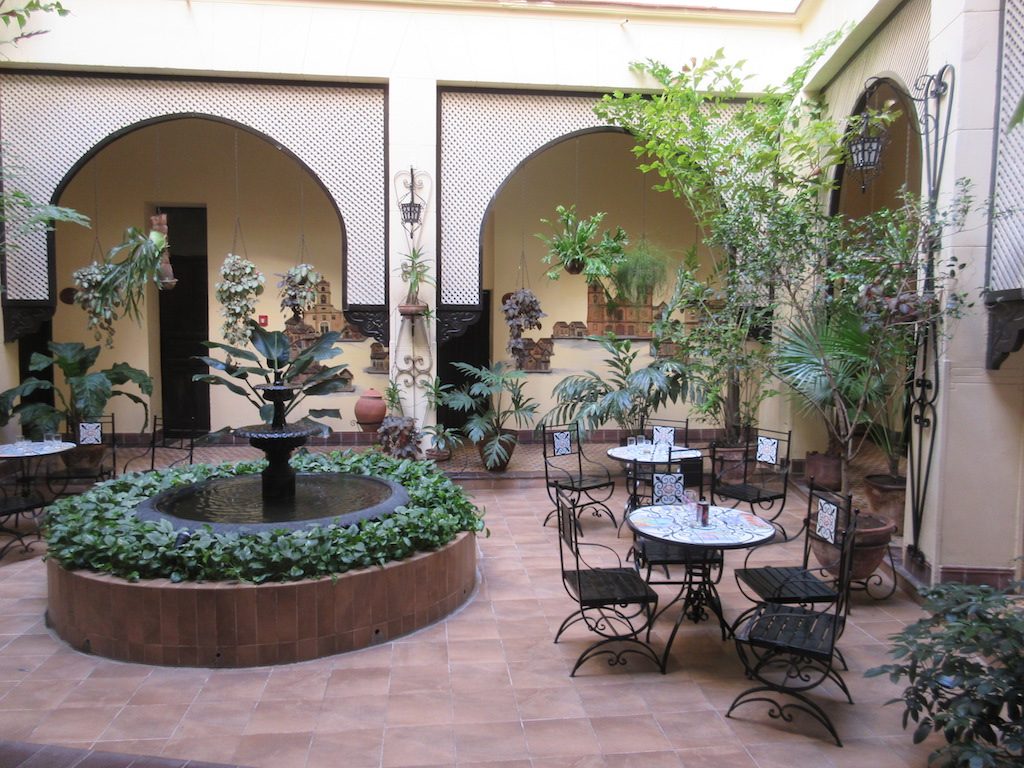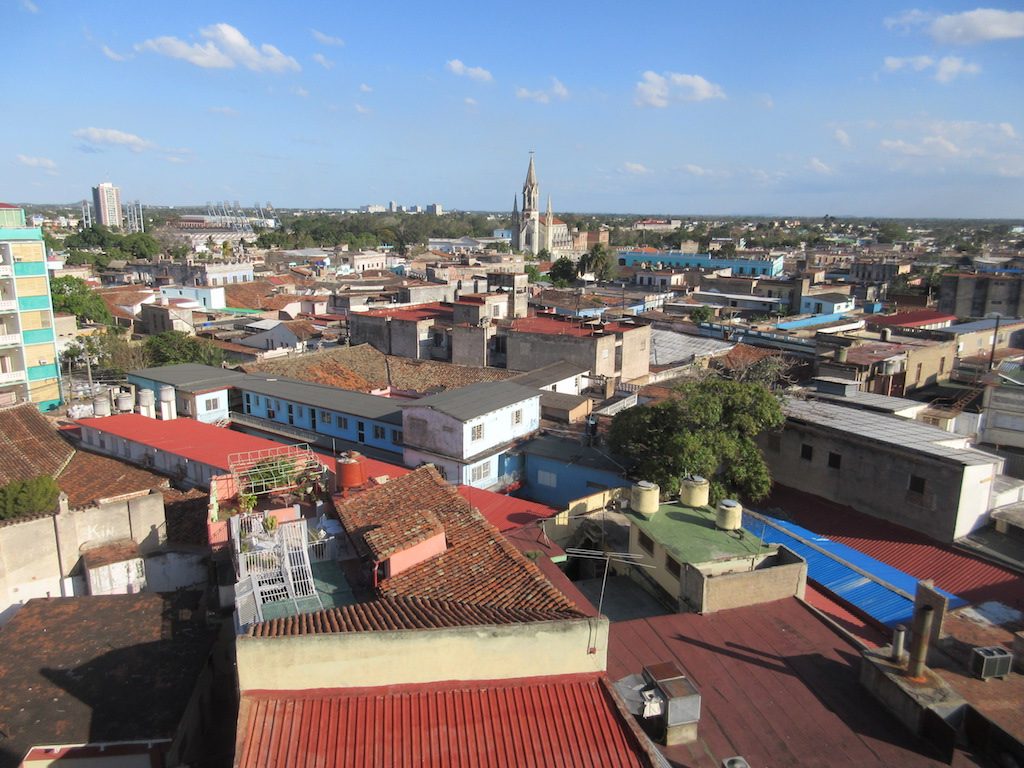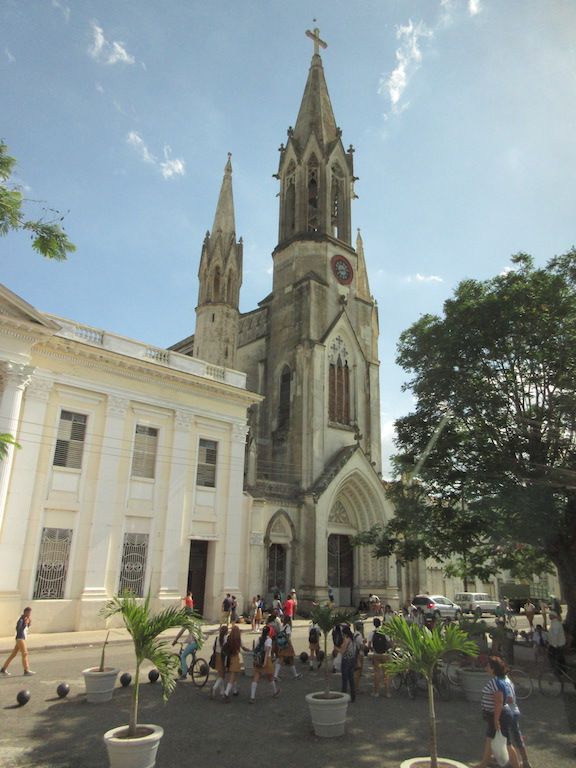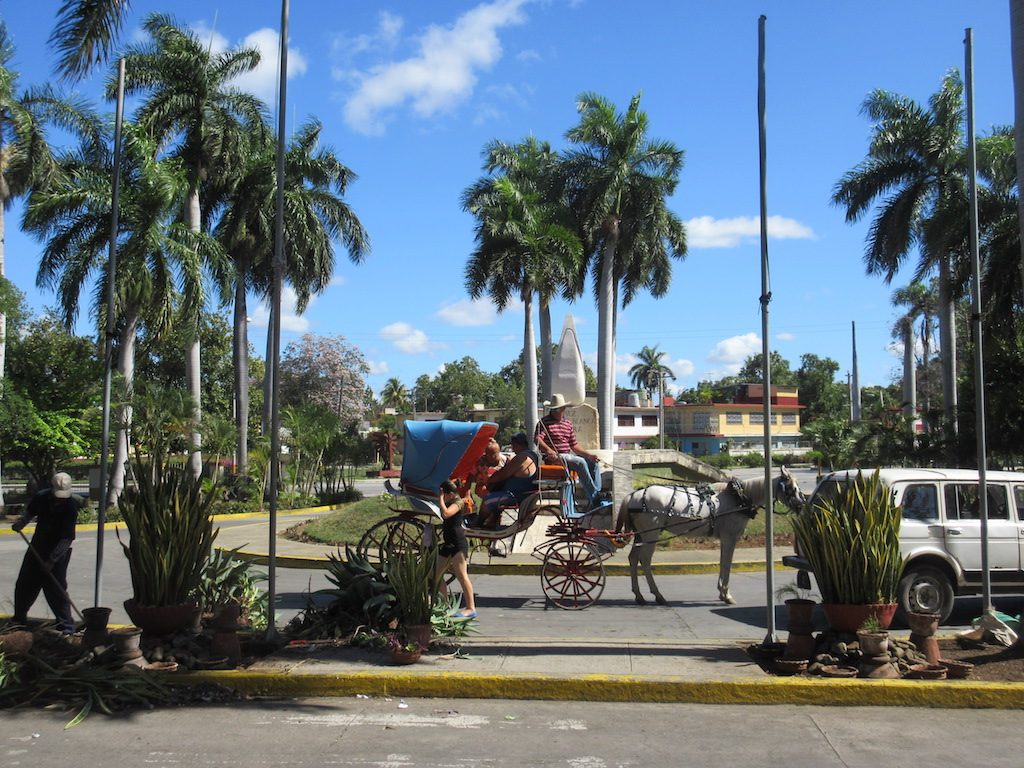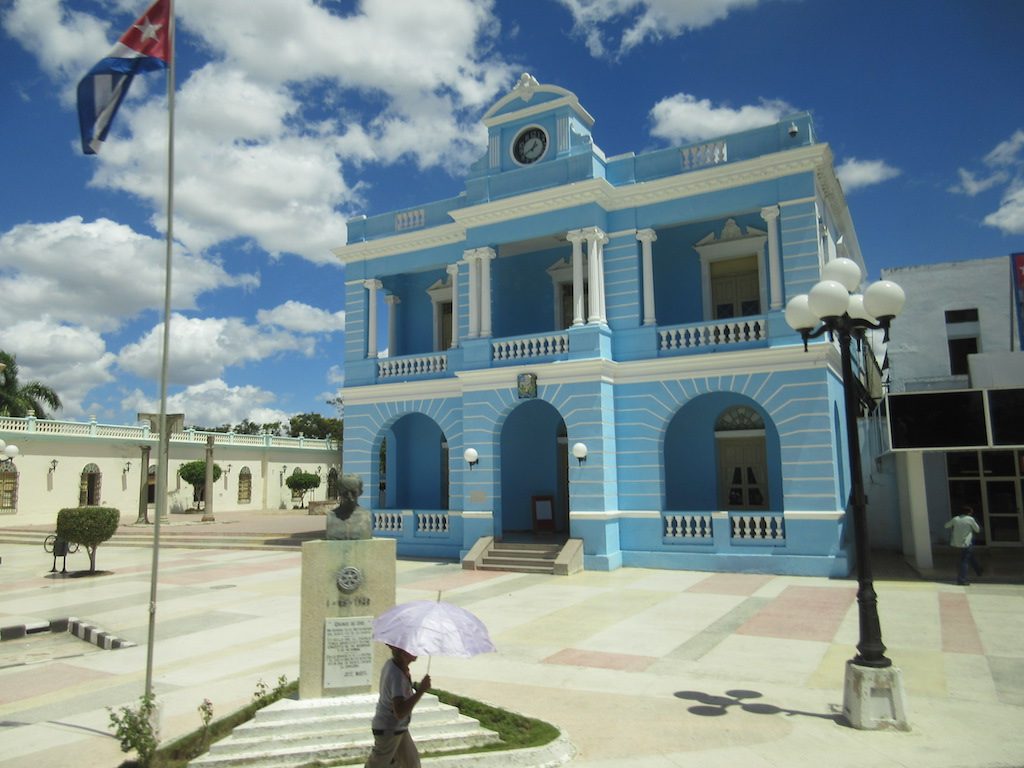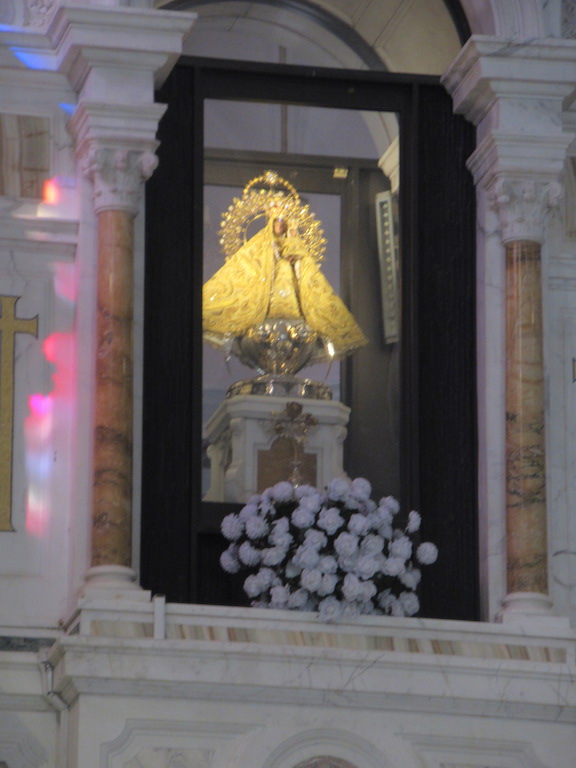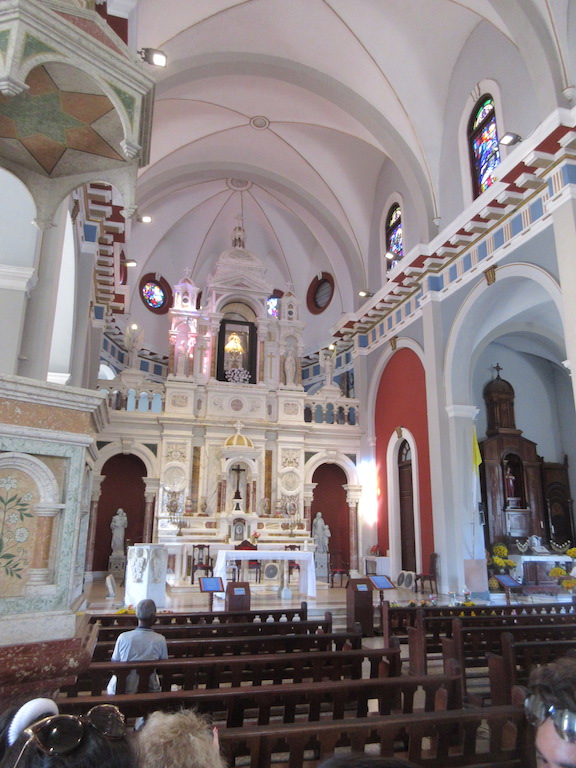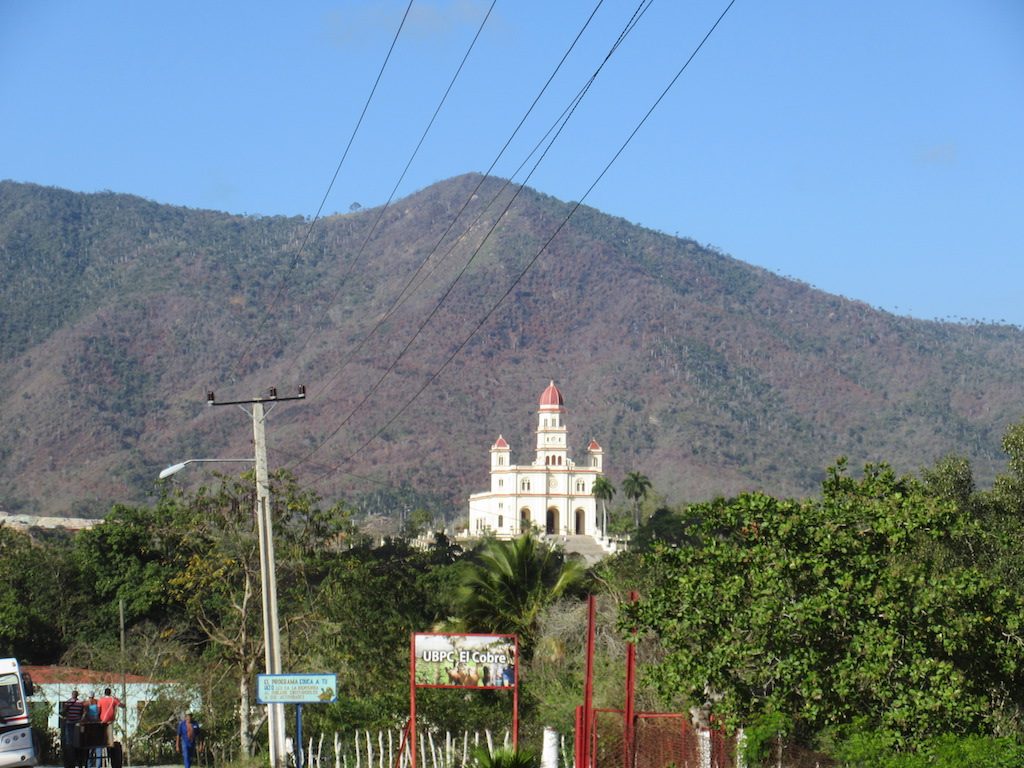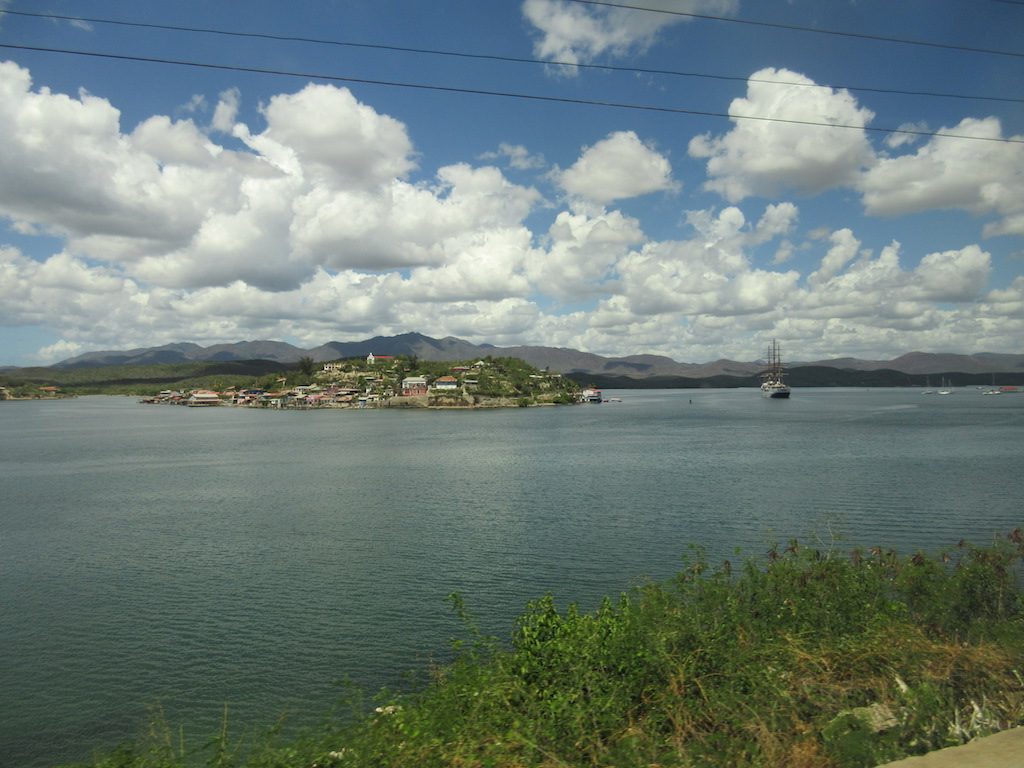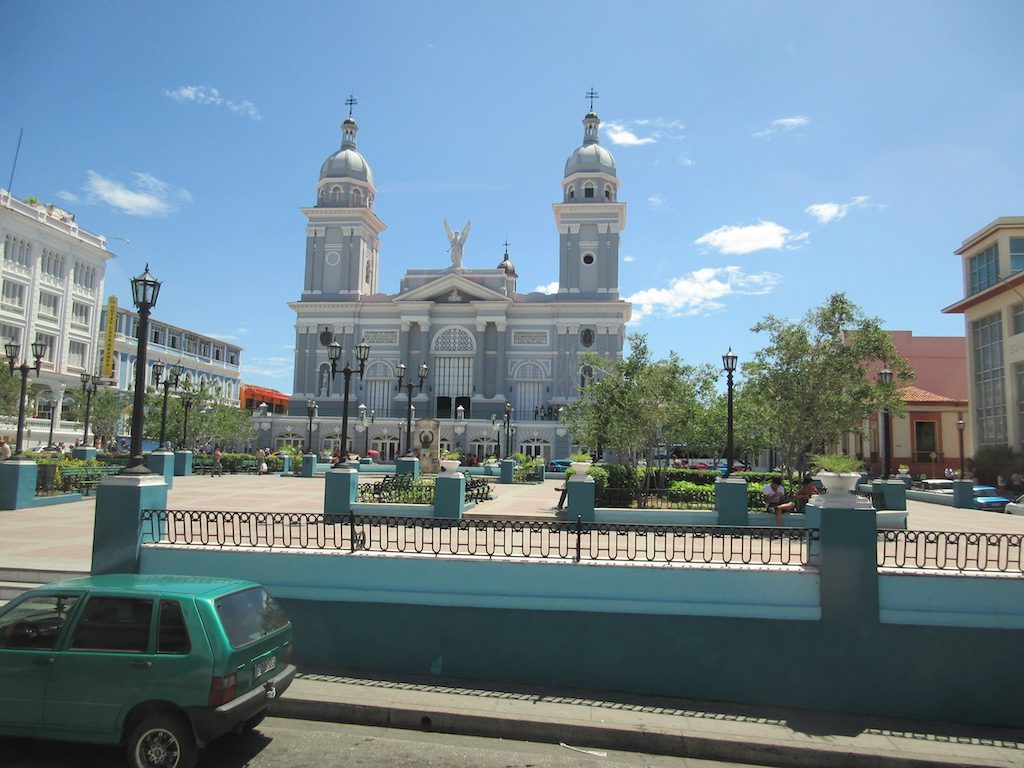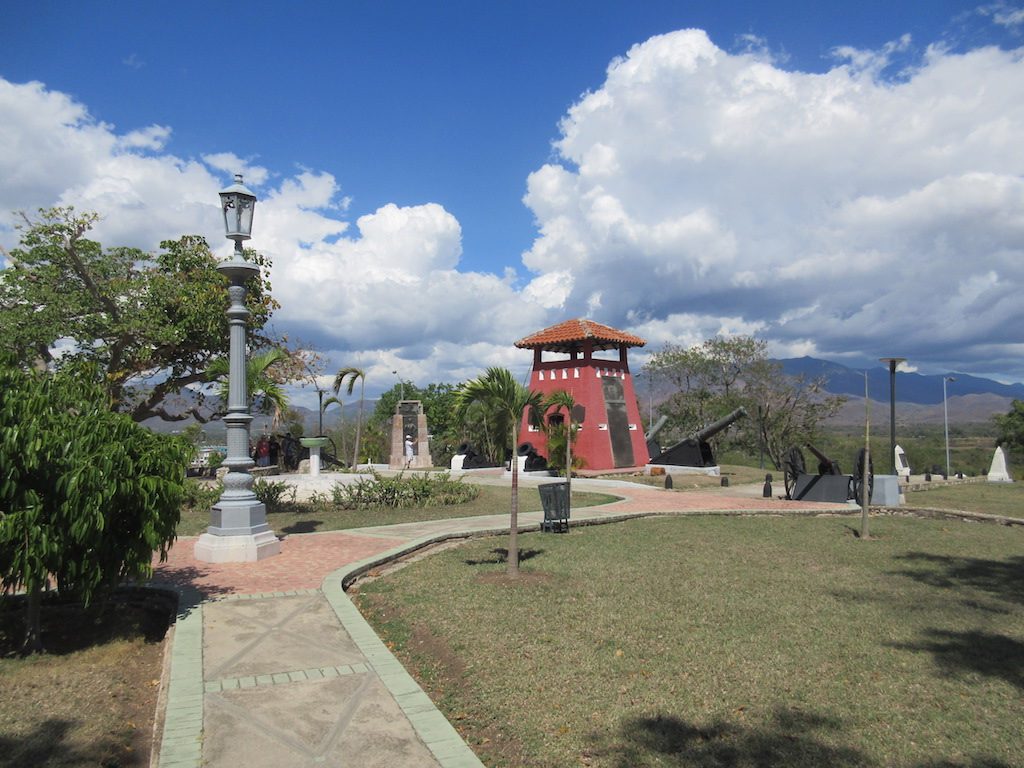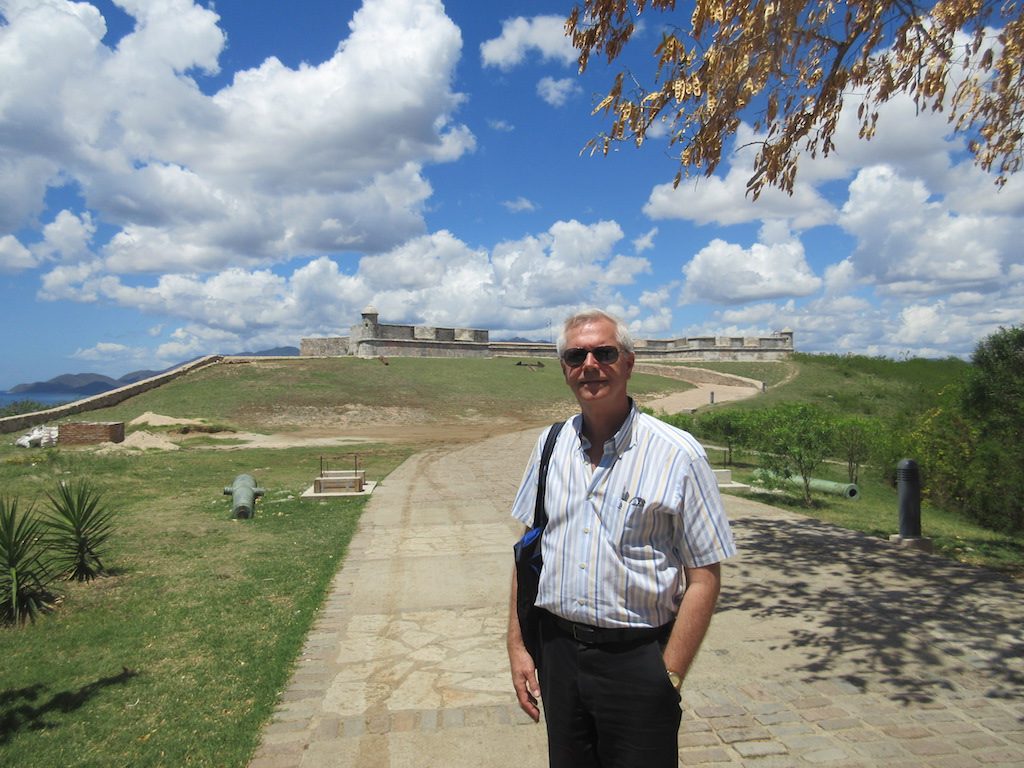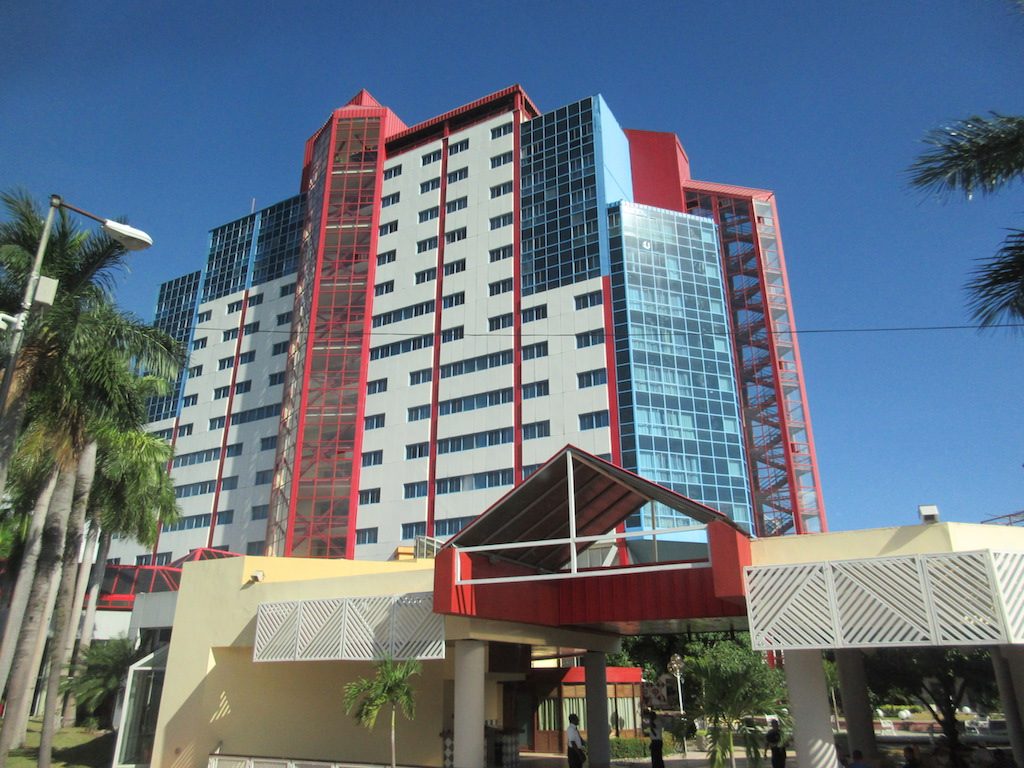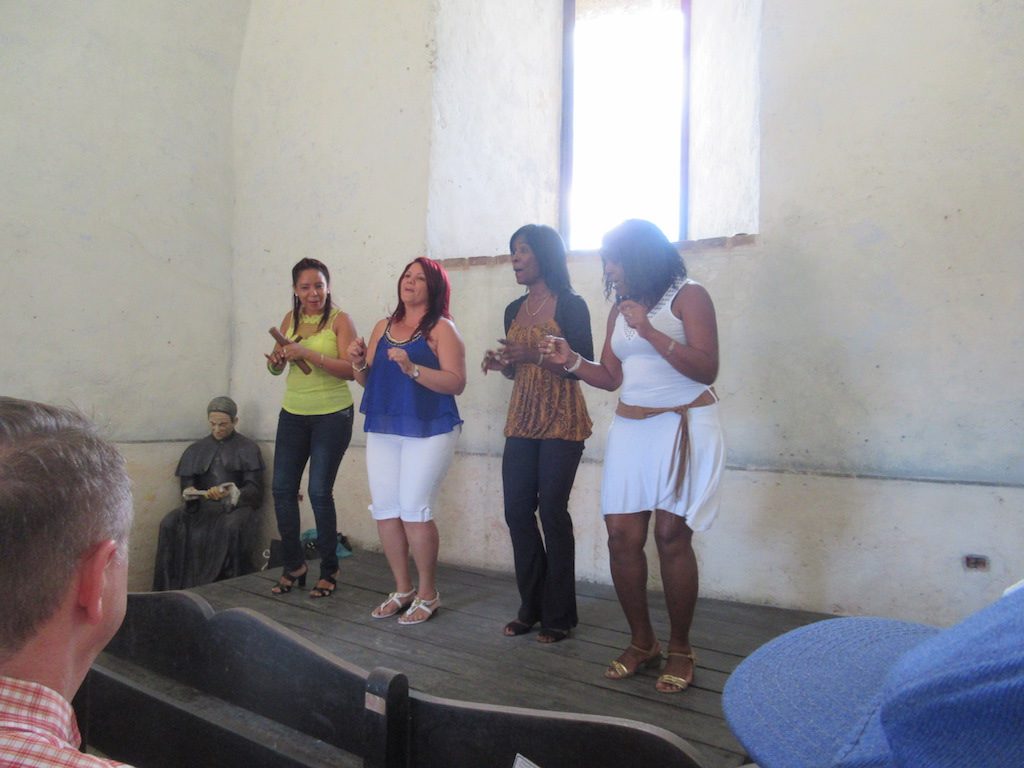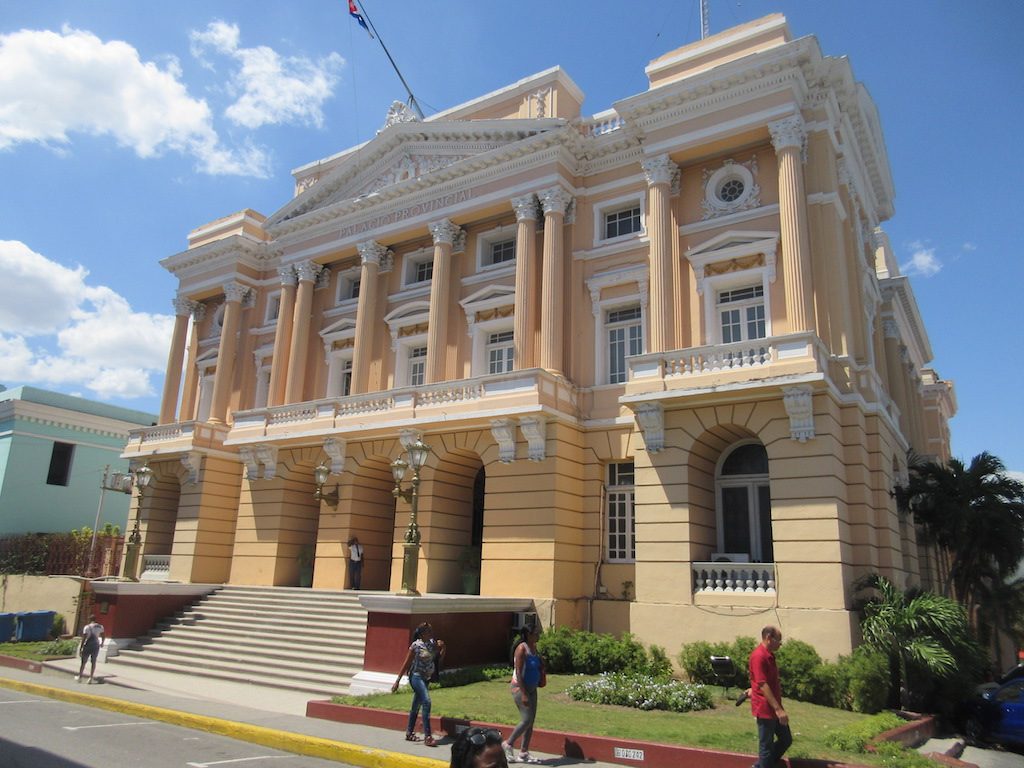We had a very early departure from the hotel, with a 5:15am continental breakfast in the lobby before departing for the airport. Our flight from Havana to Miami was delayed for the better part of two hours as the airlines computer system was down and passenger ticketing needed to be done by hand. Once we arrived in Miami at the airport around noon, we had lunch with group members Celeste and Theresa who also had later flights. We had a long wait until our flight for San Diego departed at 7:40pm, arriving home after 10:00pm.
Category Archives: 2017 Cuba
April 4, 2017 Havana
There is a local Havana Dance Company that we visited on this morning. This particular dance company is privately funded and not run by the government. They gave us a performance of their unique dance and music experience. They use their bodies to clap, stomp their feet move as well as play everything from the drums to the kitchen chairs. They were really very talented young women and it was a pleasure to see them perform.
We also visited the Casa Fuster or home of artist Jose Rodriquez Fuster, known as the Picasso of the Caribbean. Jose, now in his 60’s, is a painter, ceramicist, and creator. He is most famous for transforming his poor neighborhood with ceramic mosaics. For the last 30 years he has been covering most any surface he could find in the neighborhood with ceramic tile mosaics. He now has a team of 15 neighborhood artists who assist him with his creations. His own private residence is like a Disneyland of mosaics. The floors, ceilings, benches, railings are all entirely covered with mosaic tile. In addition, there are many creations of animals, figures, and creatures all made of concrete and steel and then entirely covered in ceramic tile mosaics. The homes all around the neighborhood are now also covered with similar mosaics and several neighbors have set up souvenir stands in their yards to cash in on Jose’s success.
For lunch we had something unique. We went to a paladar called the Mediterraneo Paladar where we enjoyed a lunch of pasta, pizzas, salads and ice cream. After lunch a famous retired Cuban baseball player named Rolando Matias spoke with us about his career in local baseball. He had many opportunities to sign with American ball teams in the late 1950’s but could not imagine leaving his family in Cuba to play ball in the states. Many of his baseball accomplishments still stand today, of which he is extremely proud.
We also visited Finca Vigia, Hemmingway’s farm about a 30-minute drive from town. The home has been beautifully maintained as it was at the time of his death. To preserve the property, they only allow visitors to view the home from the outside as they peer through the open windows and doors. It is a small two-bedroom home located on a large parcel of land in what was a very rural area at the time he lived there. We were also able to visit the pool and see one of his boats that he owned and used to fish from.
In the late afternoon we were picked up at our hotel in vintage 1950’s convertible American automobiles. They took us on about a one-hour tour of the city before dropping us off at the La Fontana Paladar for our final dinner. We dined on lobster, fish, clams and shrimp outdoors in a lovely garden. Surprise! No flan and no music!
April 3, 2017 Havana
With a population in excess of two million people, Havana is the capital city, the largest city, the major port and leading commercial center of Cuba. The city was founded by the Spanish in the 16th century due to its strategic location for the conquest of the continent. It became a stopping point for treasure-laden Spanish galleons returning to Spain.
Due to Havana’s almost five-hundred-year history, the city boasts some of the most diverse styles of architecture in the world. It has every style from castles built in the 16th century to modernist present day high-rises. The Old Havana section of town consists of the original core of town with mostly western style architecture. Much of this area has baroque and neoclassical style architecture.
Then there is the Barrio Chino area which was once Latin America’s largest and most vibrant Chinese community incorporated into the city in the early part of the 20th century. Prior to this time, beginning in June of 1847, hundreds of thousands of Chinese workers were brought in by Spanish settlers from Guangdong, Fujian, and Macau via Manila, Philippines to work alongside African slaves. After completing an eight-year contract, many Chinese immigrants settled permanently in Havana. Interesting, but in reality we saw very few Asian’s in Cuba.
This morning we had a lecture in our hotel with a local economics professor who gave us his insights into the Cuban economy including the recent changes since more Americans have been allowed to visit the country. The increase in cruise ships in recent months, along with the increased number of flights from Miami to multiple airports in Cuba, has been dramatic. More than 500 paladars have opened in Havana alone. High end hotels like the Melia where we are staying are fully booked by American companies for more than the next year and the price of rooms has gone through the roof. Air B&B has also experienced incredible growth in the country as more and more locals try to cash in on the influx of tourists. There are also many new hotels under construction in Havana to help accommodate the high demand.
Next, we took a walking tour of Old Havana with a local architect. Eduardo showed us several of the local squares including one with a street made of wood. One of the wealthy governor’s wives did not like the sound of the horse drawn carriages as they passed by the house on the concrete street so her husband had the street replaced with wood to soften the sound. As a piece of history, they have maintained the wooden street to this day. The artist Ernest Hemmingway used to live in a hotel room in Old Town and frequented a local bar most everyday. Many buildings have been restored but there are still many more that are in dire need of renovation. We visited the main church that has been restored and is quite beautiful inside. Outside of the church there were a group of locals, including many women dressed in colorful dresses, with cigars in their mouths, wanting tourists to tip them to take a photo with them.
Our next stop was the famous Hotel National that has been frequented by every movie star, newscaster, political leader that has visited Havana over the last century. The hotel overlooks the ocean and features a lot of old world character. The bar has photos on every wall of all the famous people who have visited the hotel over the years.
After lunch at a local paladar called La Moraleja, we visited the Muraleando Community Project. This poor community, once overwhelmed by trash, has been transformed by this neighborhood community center. This community asked permission from the government to build a community center out of an old concrete water storage tank that had long ago been abandoned and had become a trash heap. Community volunteers have transformed this old trash heap into a wonderful community center where everyone is welcome to come and be creative or just hang out. The walls are covered with paintings, tile mosaics, sculptures and other works of art. The old water tank is now filled with local artist’s jewelry, paintings, sculpture and handicrafts which they sell to help finance the works of the community center. On the roof of the water tank there is now a full kitchen and covered event space where they host birthday parties, wedding receptions and community events. They offer children classes in art and welcome all to participate. It is really quite a remarkable space created by the community for the community.
We were free to have dinner on our own but we were happy to enjoy a short walk and a quiet dinner in the hotel. We retired to our room early after such a busy couple of weeks.
April 2, 2017 Cienfuegos/Bay of Pigs (Playa Giron)/Havana
The drive from our hotel to Playa Giron and the Bay of Pigs Museum took us about ninety-minutes including a comfort stop along the way. The countryside in this area of Cuba is filled with rice fields, mango, papaya, banana, taro root and plantain fields.
The museum was very modern looking with many photos, tanks, war plane remnants, weapons and news articles. Of course the museum is slanted to the view from the Cuba side of things and how powerful and smart Fidel and his men were to defeat this invasion of the southern coast of Cuba.
The Bay of Pigs refers to the failed invasion of Cuba undertaken by the CIA-Sponsored paramilitary group Brigade 2506 on April 17, 1961. The intent was to overthrow the increasingly communist government of Fidel Castro. The attack was launched from Guatemala and Nicaragua, but within three days the invading forces were defeated by the Cuban Revolutionary Armed Forces under the direct command of Prime Minister Fidel Castro. President Eisenhower allocated $13.1 million to the CIA to plan Castro’s overthrow but it was put off for President Kennedy to decide. The attack failed miserably and the invaders surrendered within three days, and the majority of the the invaders were publicly interrogated and put into Cuban prisons. Negotiations led to the prisoners being released in exchange for medicine and baby food. They say that there were 1,197 prisoners, 5 ships were destroyed, 156 Cubans and 89 mercenaries were killed, and hundreds injured.
The failed invasion helped strengthen Castro’s leadership and made him a national hero. It also strengthened relations between the Soviet Union and Cuba.
After our visit at the museum we drove a short distance around the bay to a restaurant called the Casa Enrique for another Cuban lunch of fish, rice and beans, pork, shredded goat and flan. The food was very nice. After lunch we met with a local naturalist (male) who works for the government in the management of the huge National Park in this area called the Zapata Marshlands. The park is made up of mostly marshlands that are home to crocodiles, crabs, birds, fish and a variety of wildlife.
From here we drove a short distance to the main country highway comprised of six lanes, three in each direction, bound for La Habana or as we call it Havana. The funny thing about the massive highway is that they have so few cars compared to the population that the highway was mostly empty. The drive to Havana took us about two and a half hours.
Our hotel for the next three nights was the Melia Cohiba Hotel located just west of downtown Havana on the malecon or concrete waterfront boardwalk. The hotel was much more modern and elegant than any other hotels that we stayed at. It was about 25 stories tall with nicely appointed rooms, large bathrooms, elegant public spaces, multiple restaurants and bars and several shops.
After a short rest we departed the hotel bound for a Jazz Performance and discussion by the Cuban Institute of Music musicians at a local paladar. There were four musicians playing the keyboard, a wooden box drum, a percussionist and a trumpet player. They performed a short concert while we enjoyed mojito’s and drinks. They answered questions about the local music institute and how competitive the music business is in Cuba. Most everywhere we went for a meal there would be a musical group of one type or another who would play for us.
After drinks we took a short bus ride to the El Aljibe Restaurant that has been around for more than fifty-years and is famous for it roast chicken dinners. The restaurant had a huge open air dining room with a thatched roof. They served a roasted chicken dinner family style with rice, beans, salad, appetizers and ice cream for dessert. It was very good and a bit of a change from the seafood and pork that we had mostly been eating. The only drawback was that since it was an open air restaurant, there was no air conditioning. It was originally privately owned but is now a government run restaurant using the original family recipes.
April 1, 2017 Cienfuegos
This morning our fist stop was at the local Cienfuegos Botanical Gardens set on something like 3,000 acres of land. The botanical garden was started in the early 1900’s when a Dr. Atkins from Harvard University bought a sugar plantation. He traveled the world collecting species of plants from all the tropical climates and brought them back to Cuba to create the botanical garden. They used the plants in research at Harvard University. We had a guide by the name of Hilda who gave us a brief walking tour of a small portion of the garden. She had been working at the garden for 22 years and was extremely knowledgeable about the plants. We saw a variety of plants we recognized and many that were new to us.
Next we headed to the center of Cienfuegos where we walked the main pedestrian shopping street and visited the main square named the Parque Jose Marti. Many of the buildings have been restored–or are in the process of being restored–around the main square. The great majority of the shops are all government owned at this time with the exception of some of the art shops and a clothing shop. The main square is the largest in Cuba, and being a Saturday there were lots of people out with their families shopping and enjoying the outdoors. The strange thing was that there were almost no cars on the streets around the square. There are so few cars that no matter where you go there is little to no traffic. More likely you would need to wait for a bicycle or motorcycle to pass to cross the street than to worry about a car.
We had lunch at a local Paladar not far down the coast from the center of town called the Finca del Mar Paladar. Here we enjoyed a pumpkin (Squash) soup, green salad, choice of red snapper, shredded beef or grilled chicken breast, steamed squash, green beans and ice cream or flan for dessert. We were seated on the patio at this beautiful restaurant with views of the ocean but it was very warm and humid. We had lunch with Alan and Tim, from Los Angeles, who are on the trip with us. They were suggesting that we try a new cruise website called cruisecompete.com and also Google Flights for airline tickets.
After lunch we headed to the Marti Museo Provincial (Museum on the main square) for a performance by the Cienfuegos Chamber Orchestra which has existed for 10 years and now consisted of a pianist, three violinists, two violas, a bass player, and a cello player. They performed about five songs for us, including one in which they sang. They were a small group but were very talented musicians who seemed passionate about their craft. Many had started studying at age 7 or 8. Most were in their 20s/30s and one was about 50. After the concert we looked around the small museum which had everything from early indigenous people’s tools, to fine art to home furnishings from a century ago. Unfortunately, it appeared that the roof leaked, the wooden windows were rotted and the building was in dire need of some TLC.
We had some free time to wander around after the concert and Kent found a small wooden car to purchase for our collection of travel treasures. Many of the shops sell these wooden cars that represent the vintage American and Russian cars you find throughout Cuba.
We arrived back at the hotel about 4:00pm for a rest before cocktails at our hotel at 6:00pm followed by dinner back in town at the Casa Prado Paladar. The dining room was quite small but the wait staff was very pleasant and attentive making for a wonderful evening. They served us fresh bread rolls, a warm salad of mixed vegetables, a choice of grilled pork, fish, beef, shrimp or chicken. The meats came with four sauces, a sweet and sour, mayonnaise, green pepper and creole. The main course was accompanied with white or Cuban rice and banana chips. For dessert they served flan, coffee and a large shot of sugar cane liqueur that was 33% alcohol. They also sent us home with a souvenir cigar and a key ring with a barrel of rum on it that says Cuba.
March 31, 2017 Camaguey/Trinidad/Cienfuegos
We left the hotel in Camaguey this morning about 8:00am bound for the town of Trinidad. The trip took about five hours with a fifteen-minute comfort stop at a roadside restaurant. The drive was through mostly flat dry land used for raising cattle and goats. As we neared Trinidad we began to see the foothills and mountains that line the southern coast of Cuba in this area. We stopped at a lookout point overlooking what is known as the Valley of the Sugar Mills, named this because there were once more than 50 sugar refineries located in this valley and sugar plantations were everywhere.
The meticulously well preserved colonial city of Trinidad is located in south-central Cuba with a population of about 75,000 inhabitants. Built on huge sugar fortunes amassed in the adjacent Valle de los Ingenios during the early 19th century, the riches of its heyday are still in evidence in the colonial style mansions. Rambling cobblestone streets, stately palaces and plazas are everywhere. The buildings are brightly painted in shades of pinks, greens and blues and the streets are sprinkled with vintage American cars. The town is now a UNESCO World Heritage Site and so many of the historic colonial buildings are being restored within the downtown area and the cobblestone streets must be maintained.
We had lunch at the Paladar El Dorado, located in the historic center of Trinidad. The paladar was beautifully restored with several large dining rooms complete with high ceilings and crystal chandeliers. There was a pleasant private courtyard and guest rooms for rent upstairs. They gave us a welcome drink called a banana daiquiri that tasted little like bananas with rum in it. We dined on vegetable soup, green salad, bread, lobster, rice and black beans, banana chips and flan for dessert.
After lunch we walked a short distance to an African oriented religious temple called the Templo Yemaya to meet the local priest. This Santeria religion was brought to Cuba by African slaves who worked in the sugar plantations and is one of the three main religions practiced in Cuba.
We then were given a short amount of time to wander the cobblestone streets of town to explore the architecture and shops on our own. The town was by far the busiest that we have seen thus far, with tourists filling the streets. There are many of the old homes and buildings that have been converted to art galleries and shops on the lower floors and sell all sorts of carved wooden figures, paintings, handicrafts, T-shirts and other items. On several of the streets there were flea markets filled with booth after booth of more souvenirs and artwork. It appears that with all of the tourists in town, everyone is an entrepreneur. You cannot walk far without someone asking you if you want to buy Cuban cigars.
We boarded the bus about 4:00pm for a 90-minute drive to our hotel for the next two nights called the Faro Luna Hotel in Cienfuegos. Cienfuegos, named after a local founder, is located on the southern coast of Cuba about 160 miles east of Havana and has a population of about 175,000. Settled by French immigrants more than 150 years ago, Cienfuegos is often referred to as the “Pearl of the South” because of its impressive beauty and colorful history. The hotel overlooked the Caribbean Sea to the south. We had dinner with the group in the hotel’s restaurant called the Caribe.
March 30, 2017 Camaguey
Our first stop on this morning was at the Camaguey Ballet rehearsal halls located on a huge estate property. The ballet school is more than 50 years old and is government funded with a troop of about 40 dancers. The ballet company performs all over the nation and has toured all over the world, although not in the U.S. There are two large dance halls with tons of windows but no air conditioning. One room is for the male dancers and one for the female dancers who train five days a week and eight hours a day. They are paid by the government between 250 and 690 Cuban pesos a month, or the equivalent of $10 to $25 a month U.S. We were also able to visit the in-house shoe shop where a crew of workers makes all of the required dance shoes for the the dance troop. They are able to make them for less money than they can buy them and the quality is better. As much as these dancers perform and train they go through a pair of shoes every couple of weeks.
After a comfort stop at the local international airport we drove for about 75 minutes to the King Ranch, a 40,000 acre cattle ranch. The ranch was once privately owned by Americans, but today is owned by the Cuban government. Only about 3,000 acres of the ranch is currently being used to raise cattle by a staff of about 200 ranch hands and cowboys. Due to the local drought and the lack of use of the land much of it has now been grown over by Maribu wood. This tree grows very quickly, is dense and is difficult to control. They have found that if you fence small areas of cleared land and stock it with cattle and goats that before long the goats will have continued to eat the Maribu trees’ new growth until it kills them. This is how they eliminate the Maribu.
The cowboys performed a rodeo show for us with tasks like bull riding and cattle roping. We then took horse drawn buggies a short distance to the local Cafetal village where about 200 residents live and many of the men work on the ranch. We took some school supplies, tooth paste, soaps and shampoo to the local elementary school to be distributed to the students in need. From there we toured one of the local’s home which was very primitive. They did have a concrete floor although it was cracked in multiple places. The walls were made of nothing more than a few boards covered with siding that was very worn, full of rot and falling apart so much that you could see through the walls. There were no windows but only slats of wood that gave some privacy while still allowing the air to flow through the home. The roof was made of palm fronds, but the house was extremely clean and had some modern conveniences. This home was one of the nicer ones in the neighborhood with electricity, a small TV, a refrigerator, a washer and dryer. They used to have access to water but since the drought the reservoir is too low to provide water so they now rely on a well for water. They use an outhouse and charcoal and wood to cook. The owner served us coffee, fruit and some simple cookies in the rear yard. The yard had a wonderful variety of fruit trees, sugar cane, and a few vegetables which allow them never to go hungry.
On average the village people earn only 250 Cuban pesos a month or about $10 U.S. There are about 125 homes in the village but about a quarter of them do not have more than dirt floors.
We took the buggies back to the ranch were they had prepared a barbecued pork lunch for us. They served us fresh papaya, brown rice with black beans, mashed potatoes, pork and rice pudding for dessert. It was all very good.
On the return to Camaguey we stopped at the Casanova Pottery Studio to see how the local clay pots used for water storage in the past are created. This family run business gets their clay from the local mountains and creates all sizes of pottery from a very small decorative dish to a huge pot that you could stand up inside of. The father and one of his sons create the pottery, while the other son and is wife are painters. The owner’s wife has also begun to take up painting in her 60’s. They demonstrated how they prepare the clay for the potters’ wheel and then the old man threw a variety of different pieces in a very short amount of time. Mark even had a chance to create a dish on the wheel.
After the demonstration we went next door to the showroom where you could purchase the pottery and a small gallery where they had paintings for sale.
Back in the heart of town we visited the Jose D. (Pepe) Gutierrez leather workshop and gallery. Pepe and a nephew protégé showed us how they create some extraordinary leather masks and busts. At first glance you would think that all of the masks and busts were created out of carved wood, but when you pick them up you realize that they are incredibly light weight and it is not possible for them to be made of wood. The leather is softened with the use of water, molded into shape, carved using modified dentist tools and then delicately painted to create these masterpieces.
We arrived back at our hotel about 5:45pm for a rest before dinner.
March 29, 2017 Santiago de Cuba/Las Tunas/Camaguey
This morning we departed our hotel at 8:00am bound for the city of Camaguey about a six-hour drive away. The drive took us through the center or Cuba which is a bit flatter and dryer looking. There were many fields with cattle and goats and most of the towns are smaller and less populated. Throughout Cuba we have seen fences or hedgerows made of cactus delineating one property from the next. The cactus is trimmed on the sides and the top creating a dense thorny hedge that they say not even a chicken can get through. We stopped in the town of Bayamo for a comfort stop at a roadside hotel. For lunch we stopped in the town of Las Tunas for lunch at a restaurant and bar called the Cache. Las Tunas is located in central-eastern Cuba along the Carretera Highway between the cities of Camaguey, Holguin and Bayamo. It has a population of about 200,000. We arrived at the Gran Hotel in the heart of Camaguey about 4:15pm.
On our long drive to Camaguey, Jesus discussed with us Guantanamo Bay, the U.S. Naval Base and how much the Cuban people would like to see the U.S. close the base and give the land back to the Cuban people. The U.S. occupied Cuba for about four years after the War of Independence and before the Platt Amendment named after a Congressman who wrote a unilateral plan to give the the U.S the right to occupy a portion of the country as a military base. This was supposed to be a lease agreement at a cost of 2,000 pesos per year. The lease payments were paid by the U.S. until 1959 and nothing has been paid since. At one time about 1,000 Cuban people worked on the 50 square mile base along with about 2,000 U.S. servicemen, but today no Cubans are employed. The Platt Amendment was abolished in 1934 but the U.S. still occupies the land even without consent of the local government.
Camaguey is the nation’s third largest Cuban city with a population of about 325,000 inhabitants. This city was moved inland from the coast around 1528 to avoid continuous attacks by pirates. Due to their pirate experiences, the new city was built with a confusing maze-like lay-out of winding alleys and streets. The symbol of the city is the clay pot or “Tinajon,” used to store rain water for future use. Clay pots are found everywhere throughout the city. The city was designated a UNESCO Heritage Site in 2008, so they have been busy restoring many of the historic buildings.
Our hotel for two nights was the Gran Hotel, located on one of two pedestrians only shopping streets in the historic center of town. The hotel is quite an old building which has been restored and has five stories. The ground floor has an old world style lobby with dark woods, a bar, outdoor courtyard with a central fountain and a small swimming pool. Our room was smaller in size, but had about 12-foot-high ceilings with crown molding, tiled floors, vintage styled furnishings and a small bath.
For dinner we met in the lobby and walked about ten minutes to a local Paladar called the Meson Del Principe de Paladar. We had a welcome drink of rum and coke, two drinks of our choice, either chicken noodle soup or a mixed salad, an entrée, dessert and coffee. The choice of entrée’s included a lamb stew as they call it, but here it is actually a goat stew. The goat was very tasty and the meal was very good. They had a couple of musicians that played the guitar and violin as well as one that sang.
Back at the hotel we went out to the pool at 9:30pm where they had a water ballet show. Three girls and three boys did some dancing on the pool deck and then did some synchronized swimming in the pool.
March 28, 2017 Santiago de Cuba/Granma Island
We took an excursion to an old copper mining town called El Cobre that was once worked by slaves and free colored people starting in 1532. In 1670 the Spanish Crown had confiscated the mine and 270 private slaves became property of the king. That was not the purpose of our trip, but a little about the history of the town.
Cubans of all walks of life make pilgrimage to the La Caridad del Cobre Church in El Cobre to pray at the tiny statue of Cuba’s patron saint, Our Lady of Charity. The story is told that along the northern shore of Cuba near Holguin in the late 1600’s, two fishermen, and a young boy who was a freed slave, found a statue floating on a piece of wood in the ocean. On the piece of wood was written that the statue was of Our Lady of Charity. The Cuban statue measures just 16 inches tall, with a head of baked clay covered with a polished coat of fine white powder. Her feet rest upon a brilliant moon, while angels spread their golden wings on a silver cloud. This church was erected in her honor and today it is a beautiful church in excellent condition.
After our visit to the church we stopped in Santiago at the Revolution Square where we saw a large statue of General Maceo riding a horse and huge beams of steels resembling machetes pointing into the air. The statue and daggers are atop a museum which is covered in steps made of local green marble. General Maceo is highly revered in Cuba for his fight for independence. He was wounded in battle some 32 times.
Next we made our way back to the bay of Santiago near where we had visited the castle yesterday. We boarded a small motor boat to take us a short five-minute ride to Granma Island (Cayo Granma) in the middle of the bay. Once on the island we visited a restaurant where we heard from a local fisherman and two students, an 10-year-old boy and a 11-year-old girl. The kids are part of a group of more than 100 kids on the island that participate in a local program where they get tutoring from older residents. The tutoring focuses on cleaning up the island, keeping young women from getting pregnant, doing well in school and recycling old trash. We were each given a piece of art the kids had created out of recycled items like vitamin bottles, medication bottles, deodorant containers, wire, string and plastics. The art pieces were hanging ornaments of funny characters decorated in a vast number of ways from recycled materials. They give these to the visitors and ask the visitors to take photos of the characters all around the world when they arrive home and send them photos. They showed us many photos of their handicrafts from all around the world.
The address to send photos to the kids showing off their toys made from recycled materials is: Pedro E. Torres Sorio, La Sorapo, Calle Principal #8, Santiago de Cuba.
We then had lunch at the restaurant on a wonderful covered patio with a great cool breeze overlooking the bay. It was a wonderful setting for a lunch and the weather was sunny and beautiful. We were served battered and fried fish bites as an appetizer, a salad of cabbage, tomatoes and cucumbers, a white fish with shrimp, tomato sauce and cheese on top and ice cream for dessert.
After lunch we took the boat back to the mainland and made our way to the main square of Santiago de Cuba. The buildings around the square include the city hall, a church, residential housing buildings and ground floor shops. All of the buildings around the square have been beautifully restored, freshly painted and show you what can be done with the old and decaying buildings around the city.
We had some free time to explore the church and neighboring shopping streets on our own. The interior of the church has also been meticulously restored and has been painted with bright colors. The traffic is busy in the center of town and the exhaust from the trucks, cars and motorcycles is a bit overwhelming. There is a pedestrian only shopping street nearby which was filled with all sorts of locals and tourists wandering. Many of the local shops and businesses had lines of people waiting outside to get in. Not sure if they only allow a certain number of customers in at a time or if they had just not re-opened after lunch.
Our final stop of the day was at an old Bacardi Rum factory store that sold many types of rum and many varieties of cigars. The shop was smaller in size but they had some local musicians playing and there were tables and chairs where you could sit down. Lots of the people in our group took this opportunity to buy cigars as gifts for friend’s back home. The cigars are fairly expensive at about $6 a piece and up depending on the brand, size and volume that you purchase.
For dinner we were on our own, although many of us chose to visit our local tour guide Jesus’ family restaurant which was only about three blocks away form our hotel. His family runs a local paladar and we thought this would be a safer option than heading out on our own to find something for dinner. They were serving a pumpkin and taro soup, chicken dishes, pork dishes, and a variety of seafood like fish, shrimp and lobster. Everything was very good but something did not agree with Kent’s stomach.
March 27, 2017 Guardalavaca/Santiago de Cuba
We left Guardalavaca at 8:30am bound for the town of Santiago De Cuba located on the south-eastern shore of Cuba. Santiago de Cuba is the second largest city in Cuba with more than 600,000 people in the city, and more than one million in the metropolitan area. The four-hour drive took us through many small communities where people wait on the edge of the streets for public or private forms of transportation to get them where they need to go. Not many cars on the streets as they are too expensive but you find more motor bikes, horse drawn carriages and bicycles. Farming of all types is found along the way, particularly large fields of sugar cane.
Along the way we stopped at a private family farm where we could use the bathrooms, enjoy coffee, fruits and snacks. The family owns two family farms where they grow citrus, avocados, yucca roots, mango, papaya, bananas, raise goats, have a pig, chickens, ducks, etc. Each of the farms is about 35 acres in size and three generations of the family live on the property.
We also passed the small village of Biran, known as the birthplace of Ramon Castro in 1924, Fidel Castro in 1926 and Raul Castro in 1931. Their father owned a 23,000-acre sugarcane plantation here. Due to the fact that many people passed along this road to get to Santiago de Cuba, the Castro’s built a hotel, pub, post office, shop and an arena for cock fighting. The original home was destroyed by fire in 1954 but there was a replica constructed in 1974. For some reason we did not make a stop at this location.
We arrived in Santiago de Cuba at the Castillo de San Pedro de la Roca about 12:15pm. Built in 1637 the local citadel of San Pedro de la Roca is a UNESCO World Heritage site for being the best preserved example of Spanish-American military architecture. Here we took in the beautiful views over the valley of Santiago and had a short visit to explore the castle. In a small chapel of the castle we were entertained by a women’s quartet which performed a selection of five songs from Cuba and the U.S. They were delightful and appeared to really be enjoying themselves as they performed.
After exploring the castle, we had a pleasant lunch at the El Morro Restaurant next door on a vast terrace overlooking the ocean. Lunch included a beef and vegetable soup with bread, fried fish, fried chicken, mashed potatoes, white rice, a salad of tomatoes and cucumbers, and ice cream for dessert.
In the afternoon we drove a short distance to San Juan Hill where in 1898 about 2,000 Americans along with the Cuban’s fought a six-hour battle against the Spanish. More than 1,100 of our soldiers were killed in the battle. Today the site is like a park with monuments to the men who fought in the battle.
From here we drove a short distance to the Santa Ifigenia Cemetary where Fidel Castro is buried next to the grave of Jose Marti who was an early leader of the country and led the revolution against Spain for independence. We watched the changing of the guard at Marti’s grave where his ashes are entombed in a huge monument. Fidel’s gravesite is a simple rock maybe ten feet tall and twenty feet wide with just the name Fidel on the face of the stone. No date of birth or death, just a simple stone. They charge six dollars to take photos at the cemetery, so I chose not to take any photos.
The cemetery is a beautifully maintained cemetery with marble walkways and the graves of many national heroes and important families. Many of the Bacardi family members from Barcardi Rum fame are buried here.
Our hotel for the next two nights is the Melia Santiago de Cuba Hotel in the heart of Santiago de Cuba. The hotel is a fifteen story high-rise with a colorful red and blue exterior. Our room was simple with tiled floors, dark cherry colored furniture and a dated bathroom including a bidet. Simple but nothing extraordinary.
We had drinks with new friends in the hotel’s bar on the 15th floor with panoramic views over the entire city. Dinner was included at the hotel’s buffet where you could have everything from pizza and pasta to salads, cheeses, chicken, beef, pork and liver all cooked to order. The food was nothing special but more than plenty to eat.

